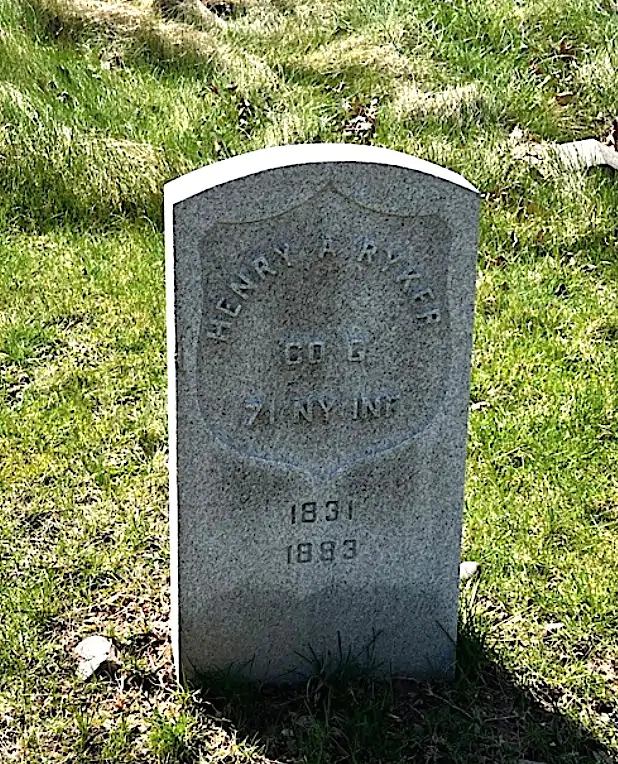RICE, RICHARD E. (1847-1891). Private, 13th Regiment, New York State Militia, Company H. Of Irish origin, he served for three months in 1861 with the 13th Regiment. He joined the G.A.R. on December 15, 1890. His last residence was at 184 22nd Street, Brooklyn. Shortly after his death from asthenia, Mary Rice applied for and received a widow’s pension in 1891, certificate 359,837. Section 59, lot 295, grave 55.
Civil War Bio Search
RICE, WILLIAM H. (1825-1907). Unknown soldier history. Although the details of Rice’s service are unknown, it is likely that he served in the Civil War because he was a resident of The National Home for Disabled Volunteer Soldiers in Togus, Maine. His death was caused by nephritis. Section 171, lot 11223, graves 7 and 8.
RICH, CHARLES H. (1839-1876). Private, 2nd New York Veteran Cavalry, Companies E and A. Born in New York State, he enlisted as a private on August 15, 1863, at Glens Falls, New York. After mustering into Company E of the 2nd Veterans Cavalry a month later on September 8, he was transferred intra-regimentally to Company A at some point, and furloughed on September 16, 1865. He was absent on furlough when his company mustered out on November 8, 1865, at Talladega, Alabama. His last residence was 172 Broome Street in Manhattan. His death was attributed to Bright’s disease. Section 13, lot 21021.
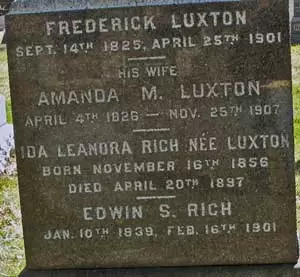
RICH, EDWIN S. (1839-1901). Captain, 102nd Regiment, New York State National Guard, Company K; first sergeant, 22nd Regiment, New York State National Guard, Company K. Rich served with two New York State National Guard regiments. He enlisted at New York City as a first sergeant (date not available), mustered into the 22nd Regiment on June 18, 1863, and mustered out after its 30-day activation on July 24. On August 6, 1864, he was promoted to captain and commissioned into Company K of the 102nd Regiment. Rich mustered out after 100 days on November 13 at New York City.
In 1897, Rich applied for and received an invalid pension, certificate 951,151. In 1901, a minor’s pension was granted under certificate 525,662. His last residence was in Allendale, Pennsylvania. He died from valvular heart disease. Section 196, lot 29649, grave 3.
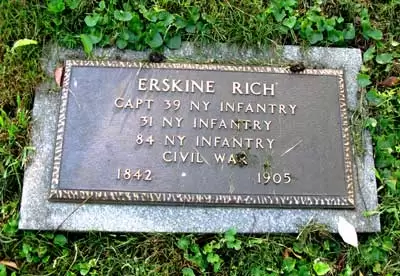
RICH, ERSKINE (1842-1905). Captain, 39th New York Infantry, Company F; first lieutenant, 31st New York Infantry, Company I; private, 13th Regiment, New York State Militia, Company F; 84th New York (14th Brooklyn) Infantry, Company H. Rich, a Brooklyn native who was employed as a clerk, was 5′ 7″, with blue eyes, light complexion and hair. In April 1861, he enlisted as a private and mustered into the 13th Regiment. He served three months in that unit, was discharged with his company, and re-enlisted at New York City as a private on September 9, 1861. Four days later, he mustered into the 14th Brooklyn. On November 18, 1861, Rich was wounded and captured while on picket duty at Falls Church, Virginia; he was paroled on February 22 of the following year at James River, Virginia. Transferred into Company I of the 31st New York on September 8, 1862, he was hospitalized briefly that month for debility.
After being promoted to second lieutenant on December 16, 1862, Rich was promoted to first lieutenant on January 19, 1863. He was again taken as a prisoner of war on May 4, 1863, at Salem Heights, Virginia, and was paroled at City Point, Virginia, on May 15. He reported to Camp Parole, Maryland, on May 16, and mustered out on June 4, 1863, at New York City. On January 22, 1864, Rich was commissioned into the 39th New York Infantry, Company F, as a first lieutenant. He was wounded on May 12, 1864, at the Salient at Spotsylvania Court House, Virginia, promoted to captain on December 31, 1864, and mustered out at Alexandria, Virginia, on July 1, 1865.
Rich returned to Brooklyn after the War and worked as a city weigher. In 1899, he applied for and received an invalid pension, certificate 993,939. Applications for an increase in 1902, 1903 and 1904 were rejected in spite of numerous chronic medical conditions. He succumbed to phthisis (tuberculosis). He last resided at 4810 14th Avenue in Brooklyn. Section 43, lot 212.
RICH, HARVEY J. (or I.) (1836-1873). Second lieutenant, 71st Regiment, New York State Militia, Company C. Rich, who was born in New York State, enlisted at New York City as a second lieutenant on April 19, 1861, was commissioned into the 71st Regiment on May 3, and resigned his commission on June 1, 1861. His last address was in San Francisco, California. His death was attributed to general debility. Section 153, lot 21633.
RICH, SAMUEL (?-1898). Private, 71st Regiment, New York State Militia, Company D. Born in New York, Rich served for three months with the 71st Regiment in 1861. In 1891, his application for an invalid pension was granted, certificate 760,626. He last lived in New York City. Section 13, lot 21021, grave 3.
RICHARDS, CHARLES H. (1837-1883). Captain, 13th Virginia Infantry, Company C, Confederate States of America. Born in Virginia, Richards was 6′ 1″ tall with a dark complexion, dark eyes and “mixed hair” when he enlisted at Gordonsville, Virginia, as a lieutenant, on April 17, 1861, the same day that he was commissioned into Company C of the 13th Virginia. On July 1, 1861, he was promoted to second lieutenant and became first lieutenant on April 23, 1862. He was promoted to captain on May 15, 1863, and was posted to acting commander of his unit on September 29, 1864. On October 19, 1864, he was wounded by a round ball in the left thigh at the Battle of Cedar Creek, Virginia, taken as a prisoner of war two days later, and confined at Fort McHenry, Maryland. On October 24, 1864, he was moved to Fort Delaware, Delaware. The muster roll for December 1864 notes that he was released from the U.S. General Hospital (West Building’s Baltimore Hospital) on December 9, 1864, and returned to Fort Delaware where he remained incarcerated until he took the oath of allegiance on June 17, 1865, at which time he was released. His last address was in Brooklyn. He died while in St. Peter’s Hospital using the name of Richard Richardson. Section 81, lot 5615.
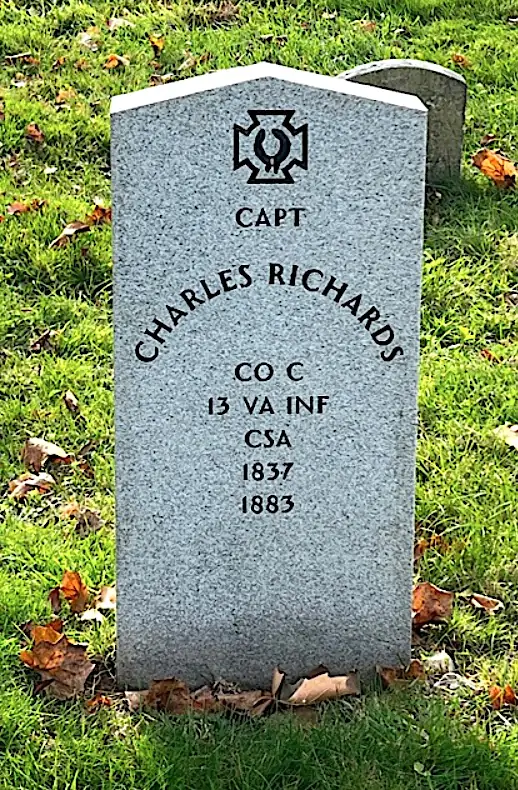
RICHARDS, SAMUEL (1836-1905). First lieutenant, 13th Regiment, New York State Militia, Company E. Originally from England, he served for three months in 1861 with the 13th Regiment. He returned to the 13th (Heavy Artillery) for three months the following year after re-enlisting as a private on May 27, 1862, at Brooklyn. In 1904, Richards applied for and received an invalid pension, certificate 1,097,334. He last resided at 20 East 127th Street in Manhattan. Section 113, lot 17020, grave 6.
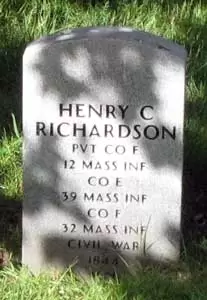
RICHARDSON, HENRY C. (1843-1881). Private, 12th Massachusetts Infantry, Company F; 39th Massachusetts Infantry, Company E; 32nd Massachusetts Infantry, Company F. Originally from Boston, Massachusetts, he was a mechanic and resident of Philadelphia, Pennsylvania, when he enlisted as a private on July 8, 1861, and mustered into the 12th Massachusetts Infantry the same day. He re-enlisted on February 16, 1864, and rejoined the 12th Massachusetts. On June 25, 1864, he was transferred into the 39th Massachusetts Infantry, and then joined Company F of the 32nd Massachusetts Infantry on June 2, 1865, where he served until he mustered out on June 29, 1865. He became a member of the G.A.R. Rankin Post #10 in 1880. His last residence was 267 Pearl Street, Brooklyn. Richardson died of diphtheria. Section 11, lot 12297.
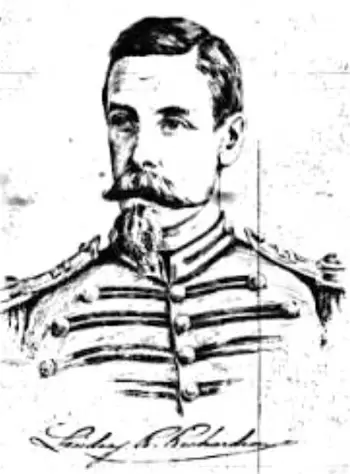
RICHARDSON, LINDSAY R. (1839-1873). Private, 7th Regiment, New York State National Guard, Company K. Born in Dublin, Ireland, to American parents, Richardson was educated in France and came to the United States for business as a young adult. According to the History of the Seventh Regiment of New York, 1806-1889 (Chapter 54, 1873), Richardson served with the 7th Regiment in 1861 and marched with his comrades to Washington, D.C.
In civilian life, Richardson was a dealer in diamonds and precious stones, a field in which he was admired and in which he achieved success. He remained active in the National Guard becoming a corporal in 1865, a first lieutenant in 1867 and a captain in 1868. As captain, he was known as a disciplinarian and military instructor; his company was one of the largest and most well-regarded in the regiment. He was praised for his intelligence, impartiality, energy and geniality.
The Veterans’ Association of Richardson’s regiment noted upon his death, “No officer of this regiment has ever achieved a more brilliant reputation or displayed more distinguished military ability. As an accomplished gentleman, as a genial companion and as a faithful friend, he endeared himself to his company and to the officers and members of this regiment, and all unite in honoring his memory.” The members of the regiment were detailed as a funeral escort and asked to wear full uniform (white trousers) when they assembled at the Armory. The funeral took place at the Church of the Ascension on Fifth Avenue and the funeral procession passed down Broadway. Masonic ceremonies were conducted at Green-Wood and Company K fired three volleys over his grave as a final lament. Resolutions of condolence were sent to his family and Richardson’s company room at the 7th Armory was draped in mourning for thirty days after his death. He last lived at 41 West 10th Street in Manhattan. He succumbed after a short but severe illness. Section 70, lot 7467.
RICHARDSON, RICHARD (1839-1910). Seaman, United States Navy. Richardson was an African-American Creole who was 5’7″ and listed his trade as a mariner when he enlisted in the Navy at New York City for a three year term on April 10, 1865. He last resided at 74 Grand Street in Manhattan. Bronchitis was the cause of his death. Section 190, lot 18430.
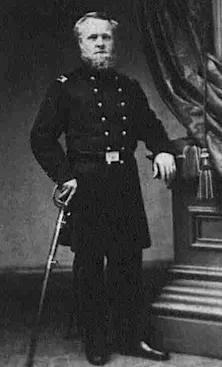
RICHARDSON, WILLIAM (1822-1893). Major and paymaster, United States Volunteers Paymaster’s Department. A native of Hertfordshire, England, he served as an apprentice to a lawyer in London before immigrating to the United States in 1834, settling first in Ohio. In 1854, he moved to Albany, New York, and was active in the formation of the first Republican State Committee. His interests ranged from prohibition and temperance to the Anti-Nebraska and Free Soil movements.
After serving as a clerk of the New York State Assembly and as Speaker of the Assembly, Richardson was appointed paymaster by President Lincoln with the rank of major during the Civil War. He enlisted on June 1, 1861, and was commissioned that day into the United States Volunteers Paymaster’s Department as its major. He served in New Orleans, Louisiana, and according to a descendant, collected ballots for Lincoln during the 1864 election from New York sailors in South Carolina’s waters. On September 30, 1864, he resigned.
Richardson’s political connections served him well after the Civil War when he became president of the Dry Dock, East Broadway, and Battery Railroad Company of New York City, turning a struggling institution into a multi-million dollar company that controlled eleven New York City railroad lines. His effort to become a state senator was unsuccessful. He last lived at 125 South Oxford Street in Brooklyn. Richardson’s death was caused by pneumonia. Section N, lot 24000.
RICHFORD, JOHN (1843-1902). Private, 17th New York Infantry, Company E. Richford enlisted as a private at New York City on May 2, 1861, mustered into the 17th New York on May 21, and mustered out on June 2, 1863, at New York City. In 1891, he applied for and was granted an invalid pension, certificate 828,431. His last residence was 62 Nelson Street in Brooklyn. In 1903, his widow, Mary E. Richford, who is interred with him, was awarded a pension, certificate 545,080. He succumbed to tuberculosis. Section 43, lot 2465, grave 1.
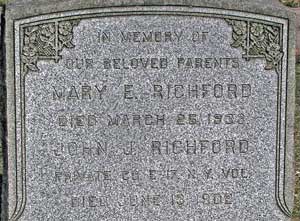
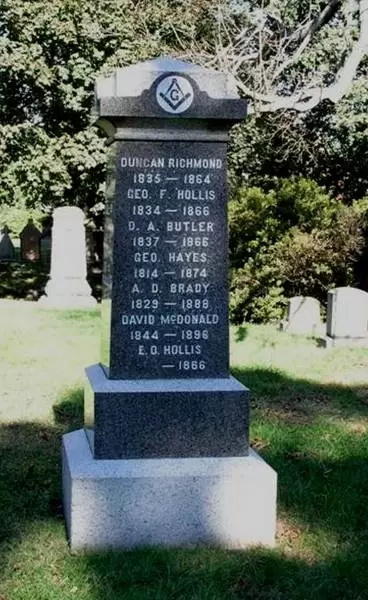
RICHMOND, DUNCAN (1835-1864). Captain 159th New York, Companies K and H; sergeant, 11th New York Infantry, Company C. In 1860, Richmond, a Connecticut native who lived at 461 Hicks Street in Brooklyn with his brother and was a silver-plater by trade, left his profession and became a firefighter at the Franklin Engine Company No. 3, located at 53 Henry Street. On April 20, 1861, he enlisted as a sergeant and mustered into the 11th New York, also known as the First Fire Zouaves or, most famously, the Ellsworth Zouaves, proudly wearing his firefighter’s badge on his uniform. According to Kevin D. Canberg, who researched and wrote about Richmond’s life and provided the information for this biography, the regiment was comprised of New York firemen, who were, at the time, considered the strongest and fittest men available to serve in the Union army. Men from Richmond’s firehouse and another nearby firehouse on Remsen Street, were part of Company C.
At the Battle of Bull Run, Virginia, at the charge on Henry House Hill on July 21, 1861, Richmond was one of 68 members of his company who were captured and first imprisoned at Richmond, Virginia. He and ten others were transferred to Castle Pinckney, South Carolina, and held there until they were paroled in May 1862. After mustering out on August 7, 1862, Richmond re-enlisted as a second lieutenant at Brooklyn a month later on September 18, and was commissioned into Company K of the 159th New York on November 3, recruiting fellow Brooklyn firefighters to fill Company K’s ranks. The 159th fought at Irish Bend and at the siege of Port Hudson, both along the Mississippi River in Louisiana, as well as smaller engagements throughout the Louisiana region. Richmond never failed to volunteer for hazardous duty (including a near-suicidal assault on Port Hudson dubbed “Forlorn Hope” that Union leadership wisely aborted), earning commendations and praise from his commanding officer. For this courage, he was promoted twice in less than a year: first to first lieutenant on March 1, 1863, effective upon his transfer to Company H and then to captain on February 20, 1864, upon which he returned to Company K.
After almost two years of fighting in Louisiana, the 159th was recalled to Washington, D.C., in July of 1864, and then reassigned to the Shenandoah Valley of Virginia. Richmond led his company through several battles in Sheridan’s decisive campaign, including Third Winchester, Fisher Hill, and Cedar Creek. At Cedar Creek, on October 19, 1864, Richmond was gravely wounded while leading his men in a defense against a Rebel charge on a breastwork behind which his men were positioned. After being removed to a field hospital, he succumbed to his wounds 11 days later. Captain William F. Tiemann wrote about his demise in 159th New York’s Regimental History, “Captain Duncan Richmond…was also killed, and the loss was most severely felt by the entire regiment. Pleasant and genial in his manner, kind to and thoughtful of his men, brave as the bravest, we could ill afford to lose so gallant an officer. He fell just as success was assured to our arms. None more worthy gave his life for his country.”
Richmond’s funeral, complete with much fanfare, was held at Plymouth Church in early November of 1864– even poet Walt Whitman, apparently a neighborhood acquaintance of the Richmond brothers, would make note of the sad event in his diary. The funeral procession, which ran from Plymouth Church along Hicks Street to Richmond’s final resting place at Green-Wood Cemetery, was an impressive event that included friends, relatives, a company of New York National Guard troops, Franklin Engine Co. 3, Lodge 288, and the Brooklyn Band. After the Freemasons, of which he was a master, performed their ancient rites and his fellow soldiers fired a volley at graveside, Richmond was buried. Duncan Richmond’s Brooklyn fireman’s badge, which he had worn so proudly into battle, was lost sometime in 1863 in the vicinity of Baton Rouge, Louisiana. It remained buried in the Louisiana soil for 145 years until its discovery, worn but intact, in 2008. Acquired by Kevin D. Canberg in 2009, it now resides in the collection of Kevin J. Canberg, Kevin’s father, who like Richmond, served Brooklyn, his home, as a firefighter. Section 158, lot 15518.
RICHMOND, WILLIAM H. (1841-1872). Second lieutenant, 142nd New York Infantry, Company C. After Richmond enlisted as a corporal on August 13, 1862, at Waddington, New York, he mustered into the 142nd New York on September 29. He was promoted to sergeant on April 15, 1863, to second lieutenant on March 18, 1865, and mustered out at Raleigh, North Carolina, on June 7, 1865. His last residence was 59 Quincy Street in Brooklyn, New York. Consumption was the cause of his death. Section 59, lot 1474, grave 10.
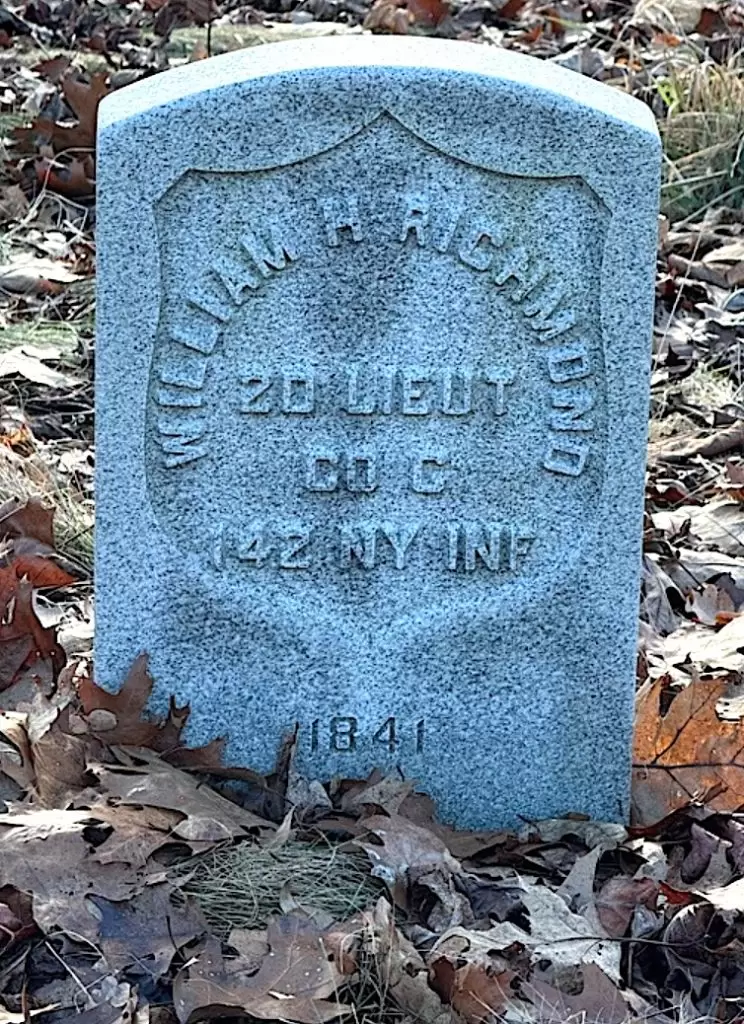
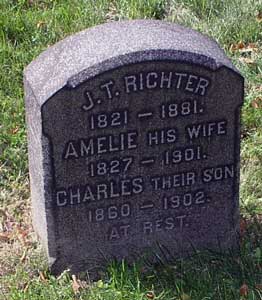
RICHTER, JULIUS (1821-1881). Private, 4th New York Cavalry, Companies B and D. Born in France, Richter served as a private in the 4th New York Cavalry in Companies B and D. His military record indicates other service but further details are unknown. He last lived at 504 East 11th Street in Manhattan. His death in 1881 was attributed to erysipelas, a bacterial skin infection. Section 2, lot 5499, grave 1260.
RICKARD, JOHN (1814-1872). Private, 70th New York Infantry, Company C. A native of Scotland, he enlisted at Paw Paw, Michigan, on October 16, 1861, and mustered into his company the same day. He was discharged for disability on February 14, 1863, at Fairfax Seminary. Rickard last lived in Brooklyn. His death in 1872 was attributed to softening of the brain. Section F, lot 20317.
RICKLIEN (or RICKLIN), JOSEPH (1814-1888). Provost, 1st New York Cavalry, Companies I, E, and G. Originally from Switzerland, he enlisted as a private on August 1, 1861, mustered into Company I of the 1st New York Cavalry, and transferred into Company E a day later. At some point, he became provost and transferred to Company G. He was discharged on December 27, 1862, due to disability. His last residence was 235 16th Street in Brooklyn. He died of marasmus, a form of malnutrition. Section 4, lot 21316, grave 137.
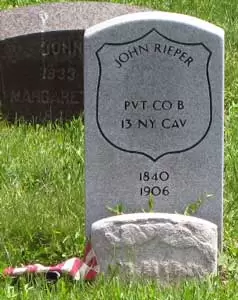
RIDDEN, JOHN C. (1830-1890). Private, 7th Regiment, New York State Militia, Company D. After Ridden enlisted at New York City as a private in 1861, he mustered into the 7th New York State Militia for its activation of 30 days and mustered out at the termination of his enlistment. His last residence was 211 Dean Street in Brooklyn. He died from rheumatism. Section 142, lot 23998.
RIEPER (or RIEBER, REVER), JOHN (1840-1906). Private, 13th New York Cavalry, Company M. Born in Germany, he enlisted as a private on February 29, 1864, at the Ninth Congressional District, and mustered into the 13th New York Cavalry on that day. Although military records list him as a deserter on May 14, 1864, that may not be correct, because, according to his obituary, he was a member of the Adam Goss Post #330 of the G.A.R. and the National Veterans League after the War. He last resided at 261 South 2nd Street in Brooklyn. He died from cancer. Section 135, lot 27263, grave 207.
RIESE, CHARLES (1839-1938). Private, 52nd Regiment, New York State National Guard; 176th New York Infantry, Company I. Born in Germany, Riese enlisted at Brooklyn as a private on October 18, 1862, and mustered into the 52nd Regiment’s National Guard. He then transferred into the Company I of the 176th New York on December 15 of that year. His last residence was 516 81st Street in Brooklyn where he lived to the age of 99. His death was caused by arteriosclerosis. Section 167, lot 16258.
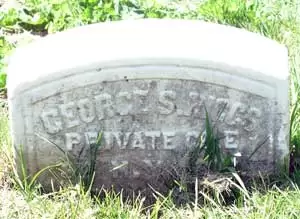
RIGGS, GEORGE S. (1829-1904). Private, 83rd New York Infantry, Company E. Riggs enlisted and mustered into the 83rd at New York City on May 27, 1861, and was discharged for disability on November 26, 1862. His application for an invalid pension was granted in 1863, certificate 278,147. He last lived at 262 Cooper Street in Brooklyn. His wife, Frances Riggs, applied for and received a widow’s pension, certificate 579,288. His death was caused by asthma. Section 190, lot 18208, grave 8.
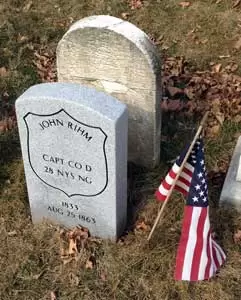
RIHM, JOHN (1833-1863). Captain, 28th Regiment, New York State Militia, Company D. A native of Germany, he enlisted as a first sergeant at Brooklyn on April 23, 1861, mustered into the 28th Regiment the next month on May 11, was promoted to captain on June 20, and mustered out at Brooklyn after three months on August 5. He returned to service on June 13, 1863, was commissioned into the same unit and company (then part of the National Guard) on that date, and mustered out after 30 days on July 22 at Brooklyn. He died a month later on August 25, 1863, of peritonitis. His last residence was on Atlantic Street in Brooklyn. A marble Veterans Administration stone was ordered for him early in the 20th century. Section 115, lot 13536 (Soldiers’ Lot), grave 17.
RIKER, JOHN LAFAYETTE (1824-1862). Colonel, 62nd New York Infantry. Born in Manhattan, his father was a merchant and New York City alderman. His maternal grandfather, John Van Arsdale, served with General Lafayette during the American Revolution. When Lafayette returned to visit the United States in 1824, throngs of Americans came to meet him at the Battery in New York City, among them John Van Arsdale, who was so pleased when he was recognized by the renowned French hero. Van Arsdales’s daughter, Elizabeth, had given birth to a son the day before (August 15), and he asked her to give his grandson the middle name “Lafayette.” John Lafayette Riker’s wife, Ann Eliza Elder Riker (who is buried in Section 57, lot 2340), died in 1851 and their son, John Lafayette, Jr., died in 1854, leaving him with a teenage daughter, Anna, when the Civil War began.
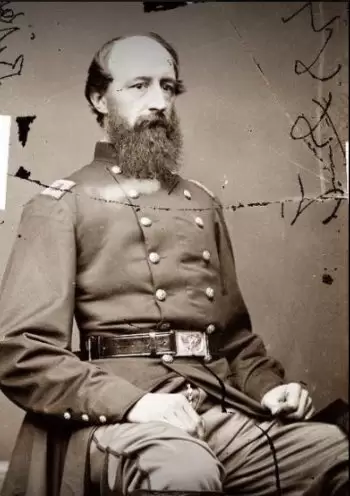
Active in the American Party, Riker was a lawyer before joining the 62nd New York Infantry, the Anderson Zouaves, at Saltersville, New Jersey, in July 1861. The regiment served in the Army of the Potomac and the troops were enthusiastically addressed by Colonel Riker as per an article in The New York Times on July 2, 1861. The aforementioned article noted that the 62nd Regiment was comprised of 950 men and were expected to head to Washington, D.C., during the upcoming week. In March 1862, Riker was court-martialed on a variety of charges including neglect of duty, creating a false muster roll, extorting money from sutlers, trying to sell a commission, and the most controversial, keeping a woman in his tent. During the testimony, many attested to their knowledge of the aforementioned woman, who was dressed as a man and named “Walter Harold” on the rolls; ultimately, he was acquitted of all charges. As per a descendant, Riker’s daughter, Anna, was also at the front lines with her father; the young girl of about 13 or 14, had no mother and so was a witness to the conflict.
After rejoining the regiment, Riker led his troops in Virginia at Fortress Monroe and at Williamsburg. He was killed at the Battle of Fair Oaks in Virginia on May 31, 1862. Mortally wounded, his last words were, “Boys, we’re surrounded-give them some cold steel.” His aide, Lieutenant Bradley, described Colonel Riker’s action in the encounter as magnificent, “the coolness of the colonel, in the most trying situations, being absolutely marvelous.” On June 5, 1862, Lieutenant Colonel David J. Nevin, 62nd New York, cited Riker’s valor when he wrote from the battlefield that the regiment was fired upon once the Confederates saw their colors, “Shortly after forming in line Col[onel] J[ohn] Lafayette Riker was killed while gallantly cheering on his men to save the battery, which was threatened at the time by the enemy. In Colonel Riker’s death we have sustained a heavy loss, as he was a gallant and brave officer.” Brigadier General Erasmus Keyes, United States Army, eulogized him in his field report of June 13, 1862, “The losses in the Sixty-second were not so great as in some of the other regiments; its conduct was good, and its colonel, J. Lafayette Riker, whose signal bravery was remarked, met a glorious death while attacking the enemy at the head of his regiment…”
Riker was an honorary member of the Mechanic Hook and Ladder Company, a group that had many members in Anderson’s Zouaves. His body lay in state in the Governor’s Room at City Hall before a military escort brought his remains to Green-Wood. According to a descendant, Anna’s great-granddaughter, one of John’s brothers, Charles Bodle Riker, became Anna’s guardian and filed a minor’s pension on her behalf. His wife’s parents, George and Hannah Elder, of Stamford, Connecticut, also played an active role in their granddaughter’s upbringing after Riker died and were the hosts at Anna’s wedding to Samuel Crump on June 30, 1868; Crump was a printer of multicolored labels for cans of food, an innovation of that era. Originally interred in lot 4259, Riker was moved to the current location at Green-Wood on December 4, 1869. Post #62 of the G.A.R., in New York County, was named in his honor.
John Riker’s brother, James Riker, an historian and author, wrote a volume about Captain Van Arsdale’s recollections and the story of how John Lafayette Riker got his middle name; the book is entitled: Evacuation Day, 1783, Its Many Stirring Events With Recollections Of Capt. John Van Arsdale, Of The Veteran Corps of Artillery, By Whose Efforts On That Day The Enemy Were Circumvented, And The American Flag Successfully Raised On The Battery, With Illustrative Notes (originally published in 1883, reprinted in 2007). Anna Riker Crump’s son, Samuel, fought and died in France during World War I; he was buried at Somme American Cemetery, a cenotaph honors his memory at Green-Wood, where his parents are interred. Section 164, lot 16159.
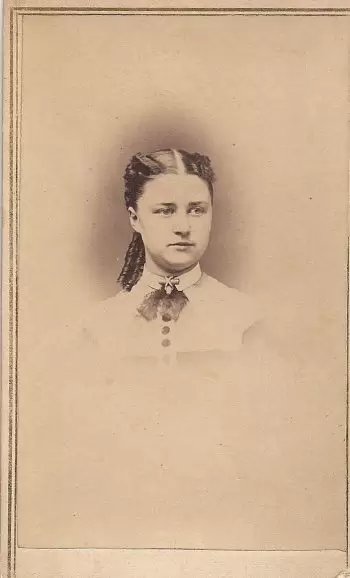
RILEY, CHARLES F. (1838-1866). Private, 5th New York Infantry, Company F. A native of New York City, Riley who was a piano-maker by trade, was 5′ 11″ with brown hair and eyes. After enlisting as a private at New York City on July 20, 1861, he mustered into the 5th two days later. He was wounded in both thighs at Second Bull Run, Virginia, on August 30, 1862, and was discharged for disability on January 17, 1863, at Hammond General Hospital in Point Lookout, Maryland. Section 114, lot 8999, grave 1269.
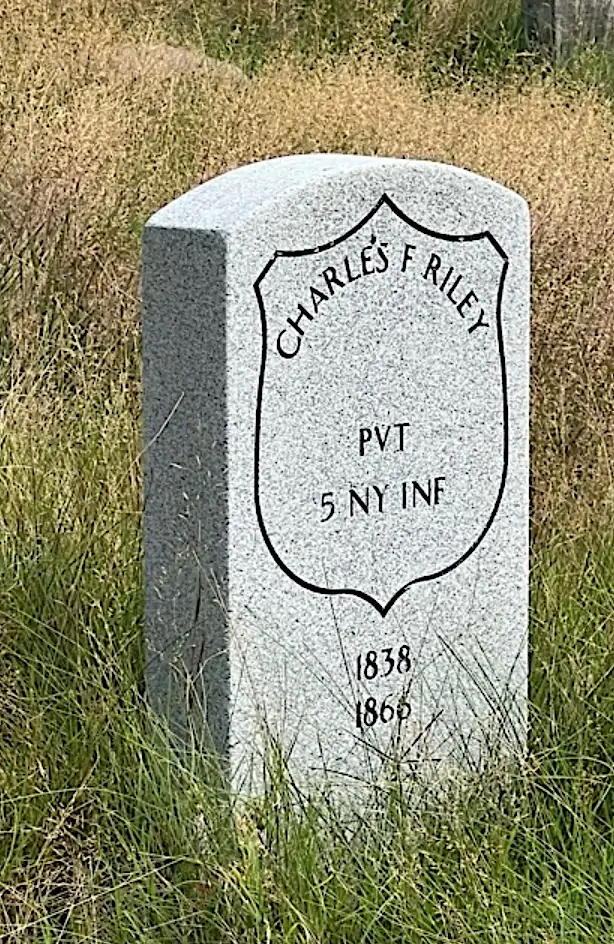
RILEY, REUBEN (1839-1919). Acting second assistant engineer, United States Navy. A native of Brooklyn, he enlisted in the United States Navy and was appointed acting third assistant engineer on August 29, 1863. He was promoted to acting second assistant engineer on November 18, 1864, and was discharged on August 20, 1865. Riley last resided at 13th Avenue and 86th Street in Brooklyn. He succumbed to cancer. Section 206, lot 35709.
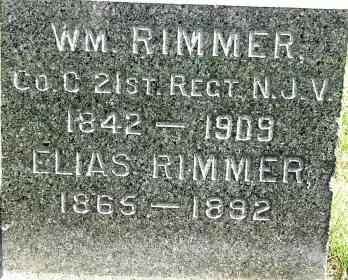
RIMMER, WILLIAM (1842-1909). First lieutenant, 4th New York Heavy Artillery, Company F; private, 21st New Jersey Infantry, Company C. Of English birth, he enlisted as a first lieutenant at New York City, mustered into the 4th New York Heavy Artillery on January 29, 1862, and resigned on June 17 of that year. He re-enlisted as a private on August 28, 1862, mustered into the 21st New Jersey on September 15, and mustered out at Trenton, New Jersey, on June 19, 1863. He last resided at 259 80th Street in Brooklyn. He died of pneumonia. Section 135, lot 27263, grave 1891.
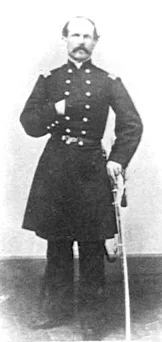
RINGOLD, BENJAMIN (1828-1863). Colonel, 103rd New York Infantry, Company A. Originally buried in lot 13536 (Soldiers’ Lot), grave 26, Ringold’s remains were removed from Green-Wood on April 20, 1883. He enlisted at New York City on December 6, 1861, as a captain, and was commissioned into Company A on January 4, 1862. He was promoted to major on June 25, 1862, effective upon his transfer that day into the Field and Staff, and rose to colonel on March 3, 1863. On May 3, 1863, he was killed in battle at Suffolk, Virginia.
RININSLAND, CHARLES (1842-1903). Private, 5th New York Infantry, Company A; 5th New York Veteran Infantry, Company A. Born in Germany, Rininsland was 5′ 3″ with gray eyes, brown hair, and employed as a clerk when he enlisted on August 27, 1862. He took sick en route to Washington, and was ultimately sent to Camp Convalescent in Alexandria, Virginia. Never having served with the 5th New York, he reported to the 146th New York in August 1863, but was never taken onto that unit’s rolls; instead, he was sent to the 5th New York Veterans, Company A, on November 3, 1863. Wounded by a Minie ball in the left leg on June 2, 1864, at Bethesda Church, Virginia, he was discharged for disability on June 1, 1865, at Willett’s Point Hospital in New York. After the Civil War, he worked as a barber. He last lived at 367 Pearl Street in Brooklyn. He died from cancer. Section 130, lot 31306.
RIPLEY, ROBERT ANDREWS (or ANDREW) (1837-1907). First lieutenant, 13th Connecticut Infantry, Companies D and C. Born in Norwich, Connecticut, and a resident of that city, he enlisted as a second lieutenant on August 23, 1862, and was commissioned into Company D of the 13th Connecticut on December 31 of that year. Upon his promotion to first lieutenant on February 15, 1863, he transferred into Company C, and was discharged on January 6, 1865. He last lived in Stamford, Connecticut. Section 140, lot 15646, graves 11 and 12.
RITCHIE, JACOB (1824-1866). Private, 84th New York (14th Brooklyn) Infantry, Engineers Company. A native of Newburgh, New York, Ritchie lived in New York City at the time of the censuses of 1840 and 1850. As per the 1860 census, he lived in Brooklyn with his wife and in-laws; he was employed as a caulker. During the Civil War, he enlisted at Brooklyn as a private on April 18, 1861, and mustered into the Engineers Company on May 23. His muster roll indicates that he was a shipwright who mustered out on August 28, 1861, at Arlington, Virginia, “being in excess of Regt. organization.”
The New York State census of 1865 reports that Ritchie lived in Brooklyn. As per his obituary in the Brooklyn Daily Eagle, he last lived on Canton Street. He died from pulmonary consumption (tuberculosis). The photos (below) of Jacob and Caroline Ritchie (who died in 1865 and is interred with him) were taken in the 1860s; his photo was taken at the Thomas Henley Studio, hers at the R. A. Lewis Studio. Section 189, lot 16067.

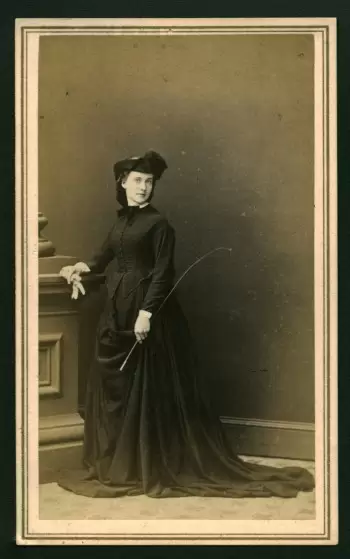
RITTER, JOHN C. (1815-1902). Gunner, United States Navy. Born in New York City, Ritter was a gunner in the Navy from September 18, 1845-March 9, 1877, serving in both the Mexican and Civil Wars. According to his obituary in The New York Times, he was employed as a clerk in the Brooklyn tax office for 20 years after leaving the service. He was a member of the Moses F. Odell Post #443 of the G.A.R. and other fraternal associations. His last address was 287 Ryerson Street in Brooklyn. His death was attributed to arteriosclerosis and senility. Section 160, lot 11497.
RITTER, PAUL (1840-1865). Private, 66th New York Infantry, Company D. On May 11, 1864, Ritter enlisted at Brooklyn as a private and mustered into the 66th New York the same day. He was taken as a prisoner of war at Petersburg, Virginia, on June 17, 1864, and was paroled on February 24, 1865, at Aiken’s Landing, Virginia. He died of consumption at New York City less than a month later on March 18, 1865. His last residence was at Third Avenue and 82nd Street, New York City. Section 163, lot 14831.
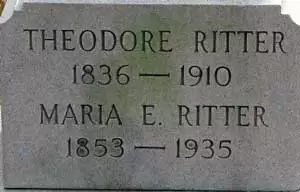
RITTER, THEODORE (1836-1910). Private, 71st Regiment, New York State Militia; 15th United States Infantry. Serving with the 71st Regiment when it was activated for three months in 1861, Ritter’s company assignment is unknown. He also served in the 15th United States Infantry. His last residence was 327 President Street in Brooklyn. Ritter died of endocarditis. Section 187, lot 17978.
RITTMAN, FREDERICK F. (1840-1899). Private, 33rd New Jersey Infantry, Company C. Born in Germany, Rittman enlisted as a private and mustered into the 33rd New Jersey as a substitute on April 13, 1865, and mustered out on July 17, 1865, at Washington, D.C. Rittman last lived at 66 Barclay Street in Manhattan. His death was caused by a pistol shot. His wife applied for and received a widow’s pension, certificate 831,865. Section 6, lot 20118, grave 17.
ROACH, HENRY D. (1844-1862). Private, 1st New York Mounted Rifles, Company M. After enlisting as a private at Hempstead, New York, on September 6, 1862, he mustered into the 1st New York Mounted Rifles two days later, and died of typhoid fever on December 13, 1862, at Suffolk, Virginia. Section 85, lot 5735.

ROAKE, JOHN SHERMAN (1832-1912). Third assistant engineer, United States Navy. A native of New York City, Roake was 5′ 7½” tall with gray eyes, a high forehead, prominent nose, fair complexion and dark brown hair. At the time of his enrolment, he was a pattern maker and engineer. After enlisting on August 19, 1863, Roake mustered immediately into the United States Navy, and served aboard the USS Sonoma and the Mary Sanford as a third assistant engineer. The ship was part of the South Atlantic Blockading Squadron in Charleston, South Carolina. He was injured on board the ship on May 4, 1864, lost sight in his left eye, reported to the New York Navy Yard for medical evaluation on June 4, and was honorably discharged on July 31, 1864, at which time his commission was revoked.
In civilian life, Roake was a mechanical engineer and draftsman (as verified by the 1880 census) and a member of the G.A.R., Lafayette Post #140 as of 1889. In 1904, his pension application was granted, certificate 35,655. At the time he applied for a pension, he noted that the nail of his left thumb was split in two at the root. His last address was 107 Hancock Street in Brooklyn. In 1914, the Pension Bureau received an inquiry asking whether his daughter, Laura Roake, was entitled to his pension. Section 193, lot 31396, grave 2.
ROBBINS, CHARLES A. (1845-1885). Sergeant, 61st New York Infantry, Companies H and K. A native of New York City, he enlisted there as a private at the age of 16 on October 15, 1861, and mustered into Company H of the 61st two days later. After being promoted to sergeant on March 31, 1863, he was transferred to Company K. Taken as a prisoner of war at Chancellorsville, Virginia, on May 3, 1863, he was later paroled. He re-enlisted on December 21, 1863, was wounded at Corbin’s Bridge, Virginia, on May 8, 1864, was reduced to ranks on April 1, 1865, and mustered out on July 14, 1865, at Alexandria, Virginia. His last residence was the Langham Hotel on 52nd Street and Fifth Avenue in Manhattan. He died of typhoid fever. Section 97, lot 4910.
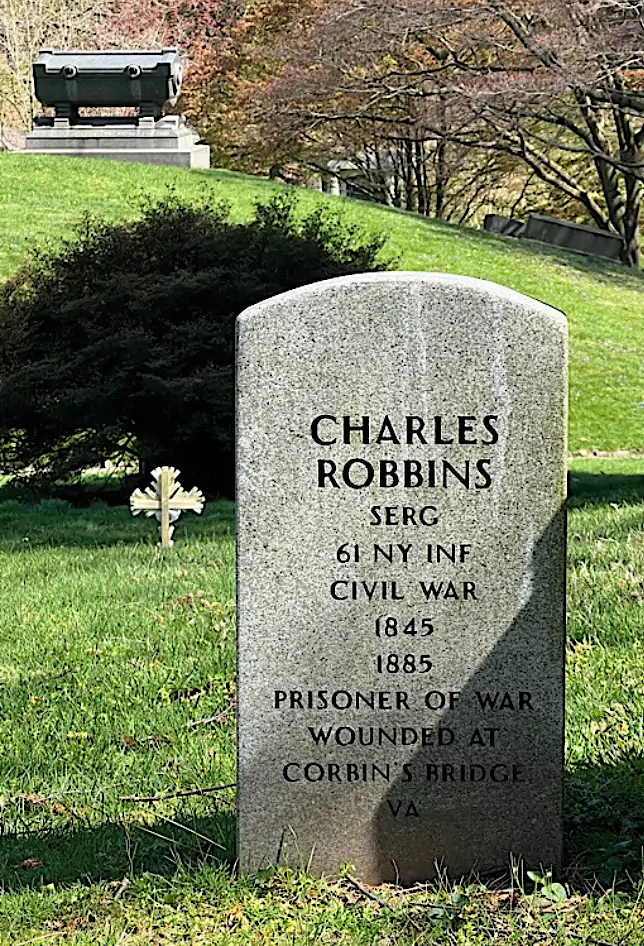
ROBEDEE, CHARLES P. (1845-1935). Private, 9th Iowa Cavalry, Company G. A Brooklynite by birth, Robedee lived in Webster City, Iowa, when he enlisted as a private on August 13, 1863. He mustered into the 9th Iowa Cavalry the same day, and mustered out on February 3, 1864, at Little Rock, Arkansas. According to his obituary in The New York Times, he served as a dispatch bearer for General Grant on several occasions. He returned to Brooklyn after the War where he was a contractor and member of the McPherson-Doane Post #499 of the G.A.R. In 1899, he successfully applied for an invalid pension, certificate 1,065,496. He last resided at 1446 72nd Street in Brooklyn. He succumbed to heart disease. Section 207, lot 21509, grave 1.
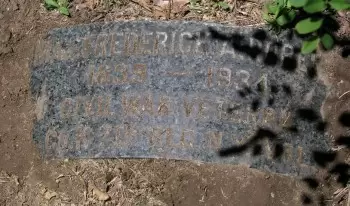
ROBERT, FREDERICK (or FRITZ) A. (1837-1934). Quartermaster, 4th New York Cavalry. Of Swiss birth, he enlisted as an adjutant on October 29, 1861, at New York City, and was commissioned into his unit on that date. Promoted to quartermaster on November 1, 1861, he mustered out at Washington, D.C., on September 5, 1862. According to William Swinton’s History of the Seventh Regiment (1876), he served in Company K of the 7th; the dates of that service are not noted. He died of senility in Atlantic City, New Jersey, at age 97. Section 187, lot 18820.
ROBERTS, BROUGHAM S. (1833-1887). Private, 38th Massachusetts Infantry, Company I. Born in London, England (although his Green-Wood record says Scotland), he was a farmer and resident of Medway, Massachusetts, when he enlisted as a private on August 8, 1862. He mustered into the 38th Massachusetts on August 21, and was accidentally wounded in the foot on March 28, 1863. Roberts was taken as a prisoner of war on June 23, 1863, at Brashear City, Louisiana, and paroled there three days later. On July 13, 1865, he mustered out at Boston, Massachusetts. His last residence was at 180 Pearl Street in Brooklyn. His death was caused by an ulceration of the larynx. Section 12, lot 9159.
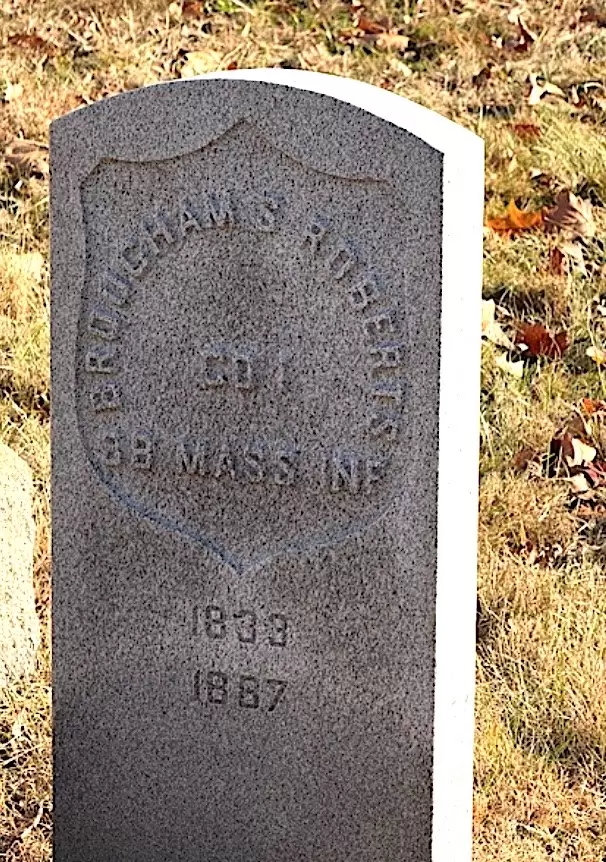
ROBERTS, GEORGE W. (1844-1899). Foreman, United States Navy. Roberts enlisted as a foreman in the United States Navy and retired as a quartermaster in 1874 from the Vermont, a receiving ship. In 1874, he received a pension of $9.75 per month from the United States Navy, certificate 1,966. A member of the G.A.R. as of July 12, 1882, his last residence was 80 Perry Street in Manhattan. The cause of his death was apoplexy. Section 153, lot 20413, grave 20.
ROBERTS, JAMES (1829-1869). Private, 3rd New York Light Artillery. Originally from England, Roberts enlisted as a private at Brooklyn on February 3, 1864, and mustered immediately into the 3rd New York Light Artillery, but was not assigned to a company. Further details about his service are unknown. His last residence was at 587 DeKalb Avenue in Brooklyn. Section 59, lot 11734, grave 68.
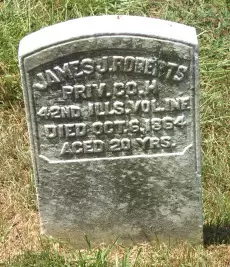
ROBERTS, JAMES J. (1844-1864). Private, 42nd Illinois Infantry, Company H. A resident of Canton, Illinois, he enlisted and mustered in on August 10, 1861. He was discharged for a disability at Jefferson Barracks, Missouri, on an unstated date. Section 117, lot 10975, grave 61.
ROBERTS, JAMES L. (or I., J.) (1837-1925). Sergeant, 6th New York Heavy Artillery, Company H; private, 8th Regiment, New York State Militia, Company D, 14th New York Heavy Artillery. Born in Staten Island, Roberts served with the 8th Regiment for three months in 1861, enlisting on April 17 and mustering out on August 2. He re-enlisted as a private on December 24, 1863, at Reading, New York, mustered into an unassigned company of the 14th New York Heavy Artillery, and transferred into the 6th New York Heavy Artillery on May 10, 1864. Roberts was promoted to corporal at some point and then to sergeant on July 23, 1865, a month before he mustered out on August 24 at Washington, D.C. His application for an invalid pension in 1890 was granted, certificate 673,731. His last address was 1 Avenue E in New Rochelle, New York. The cause of his death was senility. Section 60, lot 1033.
ROBERTS, NATHAN B. (1841-1911). Second lieutenant, United States Signal Corps; 47th New York Infantry, Company F. Born in South Egremont, Massachusetts, Roberts was commissioned as a second lieutenant in the United States Signal Corps on March 3, 1863. He also served in the 47th New York Infantry, though the details are unknown. Roberts re-enlisted on an unknown date, was commissioned as a second lieutenant but did not muster in in that rank on June 19, 1863. Subsequently, on August 19, 1863, he declined a commission in the 47th New York.
According to the 1875 New York City Directory, Roberts was working in goods for hatters at 74 Greene Street and living in Brooklyn. The 1900 census lists him as an importer. At the time of his passport application in 1901, he was 5′ 6½” tall with grayish eyes, scanty hair turning gray, light complexion, round chin, a high forehead, moderate Roman nose, and oval face. Section 76, lot 2695.
ROBERTS, JR., WILLIAM H. (1839-1932). Corporal, 83rd New York Infantry, Company H. Roberts was born in New York City, where he enlisted on May 27, 1861, as a private. He mustered into the 83rd New York the same day. During his service, he was discharged for promotion on February 1, 1863, and rose in rank to corporal. According to his obituary in The New York Times, he fought at the Battles of Bull Run, Virginia; Antietam, Maryland; and Gettysburg, Pennsylvania.
A provisions merchant after the Civil War, Roberts was also a volunteer fireman in New York City and a member of the Ulric Dahlgren Post #25 of the G.A.R in Elizabeth, New Jersey. In 1901, he applied for and received invalid pension, certificate 1,091,794. Roberts last resided at 126 Orchard Street in Elizabeth, New Jersey. His death was caused by myocarditis. Shortly after his death, Emma Roberts applied for and received a widow’s pension under certificate A-10-15132. Section 60, lot 1033.
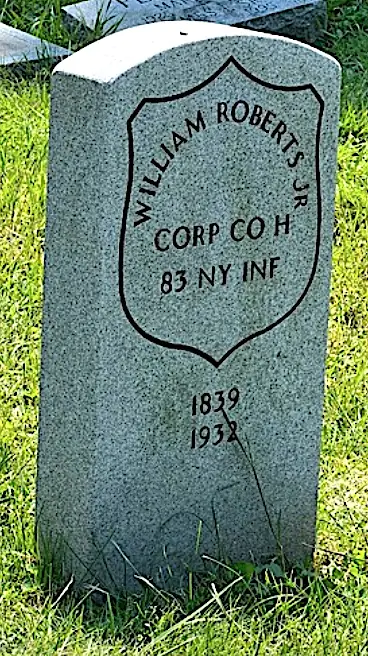
ROBERTSON, JOHN M. (1822-1870). Private, 5th New York Heavy Artillery, Company K. After enlisting as a private at the 3rd Congressional District of New York on January 13, 1864, he immediately mustered into the 5th Heavy Artillery from which he mustered out on July 19, 1865, at Harpers Ferry, West Virginia. He last lived at 80 Lawrence Street in Brooklyn. His death was attributed to delirium tremens (alcohol withdrawal). Section 184, lot 19231.
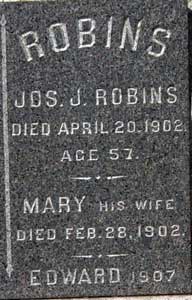
ROBINS, JOSEPH J. (1844-1902). Musician, 55th New York Infantry, Company E; 38th New York Infantry, Company I; 40th New York Infantry, Company E. Born in England on July 16, 1844, he immigrated to the United States as a boy. He enlisted as a musician at Staten Island on August 1, 1861, and mustered into the 55th New York on August 28. He transferred out of the 55th on December 21, 1862, and two days later joined Company I of the 38th New York. On June 3, 1863, he transferred out of the 38th and mustered into Company E of the 40th New York, popularly known as the Mozart Regiment. He mustered out on August 28, 1864.
After the Civil War, Robins had an oyster stand in the Fulton Market on what was known as “Oysterman’s Row” for many years. He later established an oyster and chophouse at 81-83 Court Street, opposite the old Police Headquarters, then opened a business on Fulton Street opposite the Brooklyn Borough Hall and finally opened a shop at 234 Court Street that he operated for twenty years, retiring in 1900. He was a member of the Joppa Lodge, the Masonic Veterans’ Association of Brooklyn, and the Mozart Veterans’ Association. In 1890, his application for an invalid pension was granted, certificate 991,900. He died of myelitis at his home at 14 Butler Street in Brooklyn. Section 196, lot 31052, grave 3.
ROBINSON, GEORGE B. (?-?). Second lieutenant, 23rd Regiment, New York State National Guard, Company B. He was commissioned into the 23rd on June 18, 1863, and mustered out after 30 days on July 22 at Brooklyn. Section ?, lot ?.
ROBINSON, JOHN A. (1837-1885). Surgeon, 5th New York Veteran Infantry; assistant surgeon, 38th New York Infantry; 162nd New York Infantry. Born in Dublin, Ireland, he enlisted on September 15, 1862, at Washington, D.C., and was commissioned into the 38th New York on that date. He was wounded in the right shin by the plug from a Hotchkiss shell on December 13, 1862, at Fredericksburg, Virginia, and mustered out on June 22, 1863, at East New York. Re-enlisting and commissioning in on August 27, 1864, at Harpers Ferry, West Virginia, Robinson served in the 162nd New York until he mustered out on October 10, 1864. He was then commissioned into the 5th New York as a surgeon on October 23, 1864, after enlisting that day at Weldon Railroad, Virginia, and mustered out on August 21, 1865, at Hart’s Island, New York Harbor. His application for an invalid pension was granted in 1883, certificate 369,025. He last resided in Brooklyn. His death was caused by heart disease. In 1885, Lucetta A. Robinson applied for and received a widow’s pension, certificate 235,613. Section 76, lot 2575.
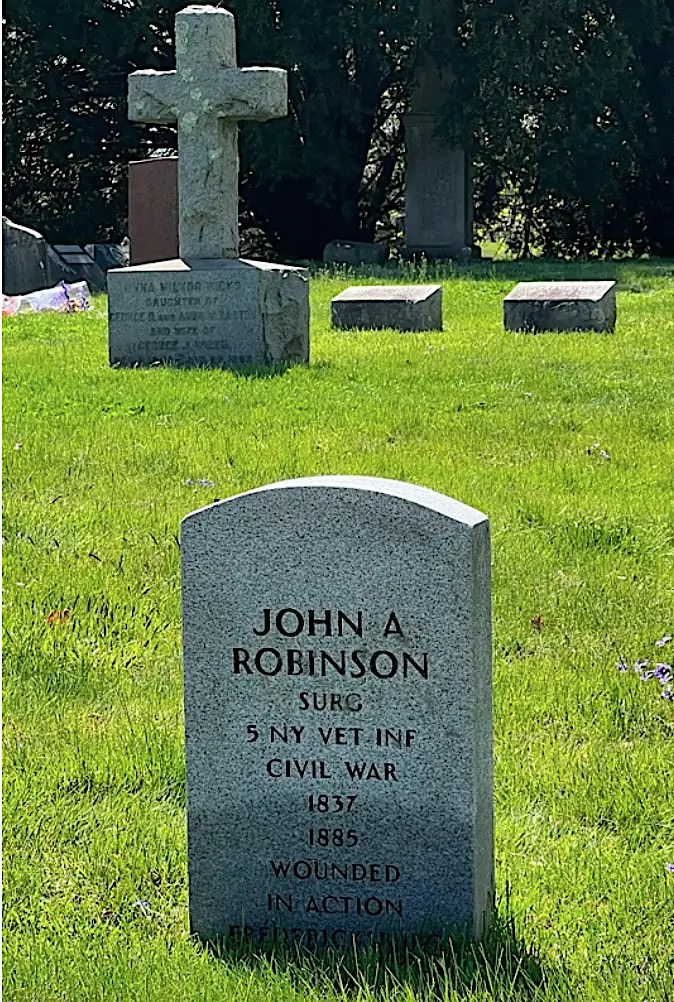
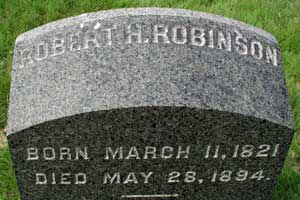
ROBINSON, ROBERT H (or R. H.) (1821-1894). Chaplain, 32nd New York Infantry. After enlisting at New York City as a chaplain on June 1, 1861, he was commissioned into the Field and Staff of the 32nd Infantry that day. His death was attributed to paralysis. He resigned on February 22, 1862. Section 4, lot 19941, grave 3.
ROBINSON, THOMAS M. (1837-1914). Assistant quartermaster and commissary of subsistence, 67th North Carolina Infantry; captain 1st North Carolina Local Defense Infantry, Confederate States of America. Robinson was born in Washington, North Carolina. After enlisting as a captain on an unknown date, Robinson was commissioned into the Field and Staff of the 1st North Carolina Local Defense Infantry on September 20, 1863. In the fall of 1863, Governor Zebulon Vance of North Carolina recommended Robinson to Confederate Secretary of War James Seddon for a commission in the Confederate forces as a quartermaster–a promotion from his position in the North Carolina state forces. A fellow captain and quartermaster seconded this recommendation in a letter dated October 17, 1863, “Capt. Robinson is serving in a section immediately bordering the enemy lines, and with the facilities that will be afforded him by Confederate Officers can secure much property that would in all probability be lost to the service otherwise.” Apparently, Robinson did not get that position—as of his return of February 1864, he remained the assistant quartermaster of the 67th North Carolina Infantry; his soldier record lists the date of that transfer as January 18, 1864. The history of the 67th North Carolina indicates that it was organized in January of 1864 and that Robinson, of Beaufort, was its quartermaster. Although his name appears as the 19th North Carolina as of March 1864 as assistant quartermaster, it is noted that that appointment was declined. As per his obituary in the Brooklyn Daily Eagle, which confirms his service in the 67th North Carolina, he was commissioned as a major in a Virginia regiment just prior to the end of the Civil War; his soldier records have no indication of that promotion.
Robinson married Mary Hoyt of North Carolina in 1865. As per the 1870 census, he lived in Baltimore, Maryland, with his wife and young children; he was a merchant whose real estate was valued at $2,000 and whose personal property was worth $800. In civilian life, he was a member of the New York Cotton Exchange as of 1876, where he held many leadership positions and served as its president for two terms. As per the 1880 census, Robinson lived with his wife and six children at 38 Cambridge Street in Brooklyn and was a cotton merchant. The 1900 census indicates that he lived at 153 Hancock Street in Brooklyn with his wife and four adult children; he still worked as a cotton broker. At the time of the 1905 New York State census, he was a cotton broker living with his wife in Brooklyn. The 1910 census shows him as having been married for 44 years, living in a rental with his wife on Washington Avenue in Brooklyn and still working as a cotton broker. Robinson was a member of St. Luke’s Protestant Episcopal Church. His funeral took place at the Church of the Messiah at Greene and Clermont Avenue in Brooklyn. He last lived at the Mohawk Hotel and died at Long Island College Hospital. Section 197, lot 33565.
ROBINSON, WILLIAM (1836-1899). Artificer, 1st New York Engineers, Company D. Irish-born and a laborer by trade, Robinson enlisted as a private at New York City on August 29, 1864, pursuant to S.O. 353 as a transferee from the 144th New York. He mustered into the 1st Engineers on September 13, 1864. On April 15, 1865, he re-enlisted at Hart’s Island, New York Harbor. His muster roll for that enlistment shows that he was 5′ 7¾” tall with blue eyes, brown hair, and a fair complexion. A bounty of $33.33 was paid to him at that time. He was discharged from military service on October 6, 1865, at Hilton Head, South Carolina, with the rank of artificer. He joined the G.A.R. on March 11, 1887, and was listed as a commander of the organization. His last residence was 210 East 31st Street in Manhattan. Robinson’s death was caused by a hemorrhage. Section B, lot 9895, grave 149.
ROBINSON, WILLIAM G. (1840-1913). Private, 7th Regiment, New York State Militia, Company C. Born in New York City, he studied in France and Germany according to his obituary in The New York Times. During the Civil War, he served for 30 days with the 7th Regiment in 1861. After joining his father’s dry goods business, he became a broker in the firm of Asch & Robinson. In 1906, his pension application was approved, certificate 1,130,350, as was the application of his widow in 1913, certificate 758,043. He last lived at 54 East 66th Street in Manhattan. He succumbed to angina pectoris. Section 149, lot 17204.
ROBINSON, WILLIAM R. (1830-1889). Surgeon, Madison’s 3rd Arizona Brigade; private, Milam County Guards Confederate States of America. Originally from Stonington, Connecticut, Robinson was the son of a New York ship broker. His paternal great-great grandfather was William Robinson, an early governor of Rhode Island. Robinson was admitted to the United States Military Academy at West Point on July 1, 1846, but resigned on January 6, 1847; he was re-admitted on July 1, 1847, but resigned on June 27, 1848, with deficiencies in math and French. At the time of his admission to the New York University Medical School in 1855, he listed his residence as California; it is possible he travelled there during the Gold Rush. Robinson obtained his degree in 1857, and was recommended by Dr. Valentine Mott (see) for his first job as a physician at the Seamen’s Retreat Hospital in Staten Island. When he obtained a passport in 1859, he was 5′ 11¾” tall with hazel eyes, a very prominent nose, small mouth, light hair, fair complexion, high forehead, and oval face.
Robinson lived with his parents at the time of the 1860 census but was a resident of Port Sullivan, Texas, on February 11, 1861, when he wrote to his father, “My bread is cast on the waters of the South.” On April 28, 1861, he wrote to his father, “War has commenced! Abe Lincoln has thrown the first stone! The South will fight to the last….” He feared a long and bloody battle and that his patients would be unable to pay him because they would be unable to sell their cotton. After joining a Texas Militia unit a week later as a private in the Milam County Guards, part of the 27th Brigade, his name was later stricken from the rolls. Subsequently, Robinson was an acting assistant surgeon in Galveston as of December 12, 1861, hoping for a more permanent position with DeBray’s Mounted Battalion. Documents confirm that Robinson was a surgeon at the General Hospital in Hempstead, Texas, from May through September 1862; from October 1862-January 1863, he was a surgeon at the Columbus, Texas, General Hospital. As per an article in the Galveston Weekly News on January 13, 1864, Dr. Robinson treated 410 patients at the Confederate States Hospital at Columbus as of its opening on October 15, 1863, 26 died of disease (e.g., typhoid, pneumonia, phthisis).
On February 13, 1863, Robinson was appointed surgeon in Madison’s 3rd Arizona Brigade, a group centered around Confederate attempts to control the southwestern territories but one that never served in the Arizona Territory as originally planned. Robinson was listed on its roster at the brigade’s headquarters in Columbus, Texas. Columbus was a staging area for Confederate troops, especially cavalry units. The Arizona Brigade camped in Columbus that winter; there many of the frontiersmen recruits were accused of insubordinate acts against local citizens. Robinson’s service was then marked by controversy and documents that raise many unanswered questions. One record dated July 15, 1863, summoned him to the Provost Marshal’s Office in Brashear City, Louisiana, by way of ferry boat with one horse. There is no further information about that court-martial but in January of 1864, he was sent to Mexico “on professional business.” The Confederates then sent him to Louisiana and possibly New York on August 3 “into enemy lines.”
Ultimately, Robinson was at Ship’s Island, Mississippi, as of November 4, 1864, as a contract surgeon at the Union prison there. While on a pass to New Orleans on January 10, 1865, he wrote to his mother, “At present I am on duty at Ships Island Miss. in charge of hospital for prisoners of war. My health appears to be Iron Clad-nothing has affected it.” He concluded his letter, “I am now anxiously looking forward to the times when we will once more be together. It is soon at hand.” On June 5, 1865, he wrote to Governor J. Madison Wills of Louisiana asking for a position in the Charity Hospital or any available medical appointment.
After the Civil War, Robinson was listed as a physician in Newark, New Jersey, in 1868, practiced in Michigan as of 1870, and returned to Newark in 1872. He then lived with his widowed mother and siblings in Newark from 1880 until his death. He was listed as a physician in the Newark City Directory in 1889. Thanks to Duane Helweg whose extensive research on William Robinson is the basis for this biography. Section 73, lot 814.
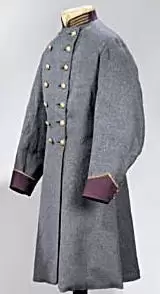
ROBINSON, WILLIAM S. (1838-1897). Unknown soldier history. According to his obituary in The New York Times, Robinson was born in Belvidere, New Jersey, and was a member of Lafayette Post #140 of the G.A.R. He was a painter who belonged to the Order of United Workmen, a fraternal organization that provided death benefits to its members. He last lived at 14 West 134th Street in Manhattan. His death was caused by gangrene of the lungs. Section 204, lot 29807, grave 2.
ROCHE, CHARLES H. (1842-1864). Captain, 12th New York Cavalry, Company A; quartermaster sergeant, 5th New York Cavalry, Company I; private, 1st New York Mounted Rifles, Company H; 2nd New York Cavalry. Roche enlisted at Plainfield, New York, as a private on September 5, 1861, mustered into the 5th New York Cavalry on October 31, was promoted to quartermaster sergeant at some point, and was discharged for disability on May 15, 1862, at Annapolis, Maryland. After re-enlisting as a private at New York City on June 27, 1862, he mustered immediately into the 1st Mounted Rifles and was discharged on an unknown date. He re-enlisted on July 18, 1862, at New York City, and mustered into the 2nd New York Cavalry on July 28. No company was assigned. Roche then re-enlisted as a first lieutenant at New York City on December 7, 1862, was commissioned into the Field and Staff of the 12th New York Cavalry on March 5, 1863, and was promoted to captain on September 24, 1863, effective upon his transfer into Company A. He died from intermittent fever on October 17, 1864, at Camp Palmer, North Carolina, and was buried in Green-Wood on March 15, 1865. His last residence was in Plainfield, New Jersey. Section 94, lot 6399.
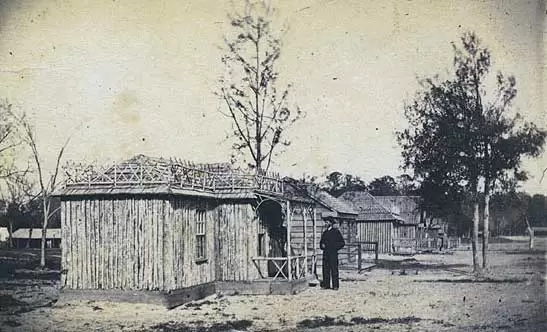
ROCKWELL, CHARLES H. (1843-1883). Private, 10th New York Infantry, Company E. A native of Hartford, Connecticut, he enlisted as a private at New York City on May 10, 1864, and mustered into the 10th New York on that day. Other details of his military record are not known. His last address was 13 West 20th Street in Manhattan. He died of asphyxia. Section 84, lot 6124.
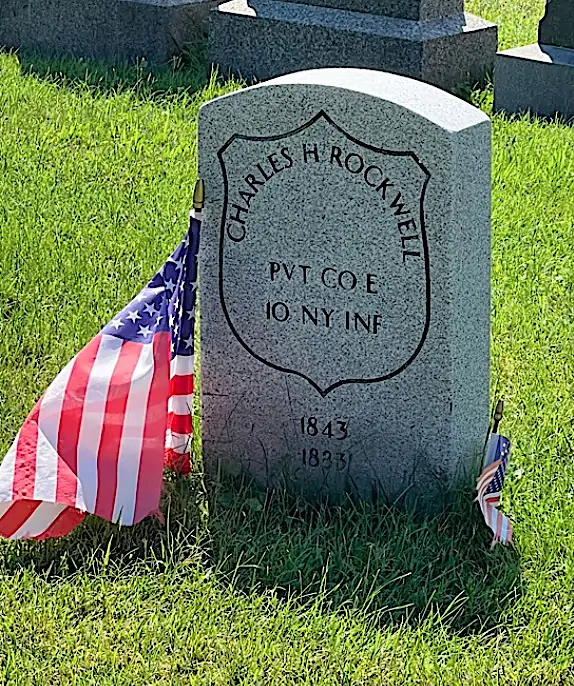
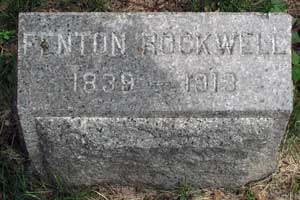
ROCKWELL, FENTON (1839-1913). Captain, 18th New York Cavalry, Companies D, M, and I; private, 7th Regiment, New York State Militia, Company I. A native of Flint, Michigan, Rockwell graduated from Columbia Law School in 1860. He enlisted in April 1861, served 30 days, and mustered out with his company on June 3 at New York City. When the 7th Regiment was activated a year later, and part of the New York State National Guard, he enrolled at New York City as a private on May 25, 1862, mustered into the same company that day, and mustered out after three months on September 5 at New York City. On August 25, 1863, he re-enlisted as a first lieutenant at Albany, New York, and was commissioned into Company D of the 18th New York Cavalry the same day. During his service, he was transferred to Company M and then back to Company D, promoted to acting quartermaster in February 1864, and promoted to captain on October 6, 1864, effective upon his transfer to Company I on February 2, 1865. He fought with the Army of the Potomac and in the Department of the Gulf. According to his New York Times obituary, he was appointed judge advocate of the Provost Court in New Orleans, Louisiana, under General Butler and later served as provost marshal in San Antonio, Texas, under Major General Wesley Merritt. Rockwell mustered out on May 31, 1866, at Victoria, Texas.
A trial lawyer in Brooklyn for 50 years, Rockwell also helped organize the Democratic Club of the 23rd Ward. He joined the G.A.R. in 1884, Post #206, the Thomas F. Dakin Post in Brooklyn, and served as its commander. He also was a member of the Seventh Regiment War Veterans. His application for an invalid pension was granted. At the time of his death, from cirrhosis, he lived at 310 Greene Avenue in Brooklyn. Rebecca Rockwell applied for and received a widow’s pension in 1913, certificate 757,780. Section 32, lot 6551.
ROCKWELL, WILLIAM (1800-1867). Surgeon, 145th New York Infantry; 18th New York Cavalry. A New Yorker by birth, he enlisted as a surgeon at age 62 on July 16, 1862, was commissioned into the 145th New York that day, and was discharged the next year on May 7. Four days later on May 11, 1863, he re-enlisted and was commissioned into the Field and Staff of the 18th New York Cavalry two days later, and served until his resignation on July 2, 1864, at New Orleans, Louisiana. He last lived in Long Branch, New Jersey. His death was attributed to apoplexy. Section 32, lot 6551.
RODAMER, WILLIAM (1839-1872). Artificer, 1st New York Engineers, Company L. Born in New York, Rodamer enlisted as a private at New York City on April 5, 1865, and mustered into the 1st Engineers that same day, having had previous service in Company F of the 83rd New York Infantry. He was promoted to artificer on May 1, and discharged on June 30, 1865, at Richmond, Virginia. He last lived on Ninth Avenue in Manhattan. Rodamer died of phthisis. His widow, Mary Rodamer, received a pension, certificate 808,857. Section 167, lot 17382.
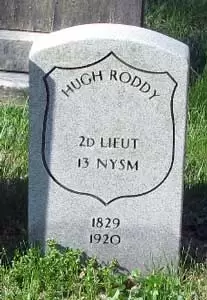
RODDY, HUGH (1829-1920). Second lieutenant, 13th Regiment, New York State Militia, Company A. On April 23, 1861, Roddy, a native of Ireland, enlisted as a third lieutenant at Brooklyn, and was commissioned into the 13th Regiment on May 17. He mustered out as a second lieutenant on August 6, 1861, at Brooklyn. In 1890, he applied for and was granted an invalid pension, certificate 1,090,499. He resided in Brooklyn at the time of his death, which was caused by myocarditis. A government-issued gravestone for veterans was ordered for him in 1902. Section 187, lot 19814, grave 2.
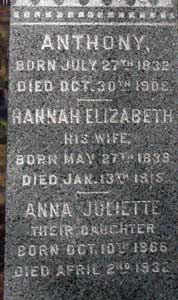
RODGERS, ANTHONY (1832-1908). Private, 8th Regiment, New York State National Guard, Company G. A native New Yorker, Rodgers was a watch-maker trained by his father James Rodgers (see) in the 1860s. After enlisting as a private at New York City on May 29, 1862, he mustered into the 8th Regiment and mustered out after three months on September 10. His pension index card shows additional service in Company B of the 1st New York Engineers, Company G of the 71st and Company F of the 84th New York State Militia; no dates are given for that service history.
In 1871, Rodgers’s application for an invalid pension was approved, certificate 999,860. He last lived at 315 Foster Avenue in Brooklyn. He died at Kings Park, New York, of acute dysentery. After his death in 1908, Hannah E. Rodgers, who is interred with him, applied for and received a widow’s pension, certificate 674,574. Section 24, lot 6848.
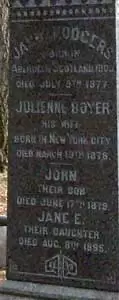
RODGERS, JAMES (1803-1877). Quartermaster, 15th New York Heavy Artillery. Born in Aberdeen, Scotland, he first trained as a carriage-maker under his father and then apprenticed and became a clock-maker. He immigrated to New York City in 1822 and took up his trade, first on Chatham Street and then at 410 Broadway. He made clocks, high-grade watches, and similar items; in 1840, he received a silver medal from the American Institute Fair for designing a device that measured revolutions of a steam engine. Rodgers also designed a machine in 1844 that was a pre-cursor to the sewing machine. More than 50 large public clocks and ship chronometers of his design were displayed in New York City in his heyday, although none are in existence today. Among his famous designs were the massive clock at Trinity Church in Manhattan (1846), the largest dial-clock at that time, purchased for the handsome sum of $4,344 and gold medal winner at the 1846 American Institute Fair.
Rodgers won many awards for his work through the years, was official regulator of the Brooklyn City Hall Clock in the 1850s, and designed the clock for New York’s City Hall in 1859. In a series of letters in September and October 1859, Rodgers was questioned about the clock that he designed for the cupola of Brooklyn’s City Hall in 1853 when he submitted a bid of $2,500 for a new clock at City Hall, New York, after the Brooklyn clock was deemed worthless and taken down. Rodgers, who wrote that he put up that clock at a low price, noted that he took care of it for four years, and knew that Brooklynites loved “the old clock.” Rodgers, who supplied testimonials attesting to his ability and workmanship, attributed the problems with the 1853 clock to vibrations of the cupola and hoped that the Street Commissioner would award him the new contract. He also designed the clock at the entrance gate to Green-Wood Cemetery (1861).
At the age of 60, Rodgers enlisted as a quartermaster at Albany, New York, on March 31, 1863, and was commissioned into the 15th New York Heavy Artillery’s Field and Staff on April 15, 1863. He mustered out on June 25 of that year at New York City. Continuing in his trade after the War, he designed the clock at Grand Central Station (1871). His son, Anthony (see), worked with his father in the watch-making business in the 1860s. At the time of his death, his office was at 102 Fulton Street in Manhattan. He last lived at 154 East 37th Street in Manhattan. His clock at Trinity Church was the site for marking New Year’s in New York City in the early 1900s. After that clock stopped working in 1905, an article in The New York Times noted that Rodgers was a great clockmaker of his day. Section 24, lot 6848.
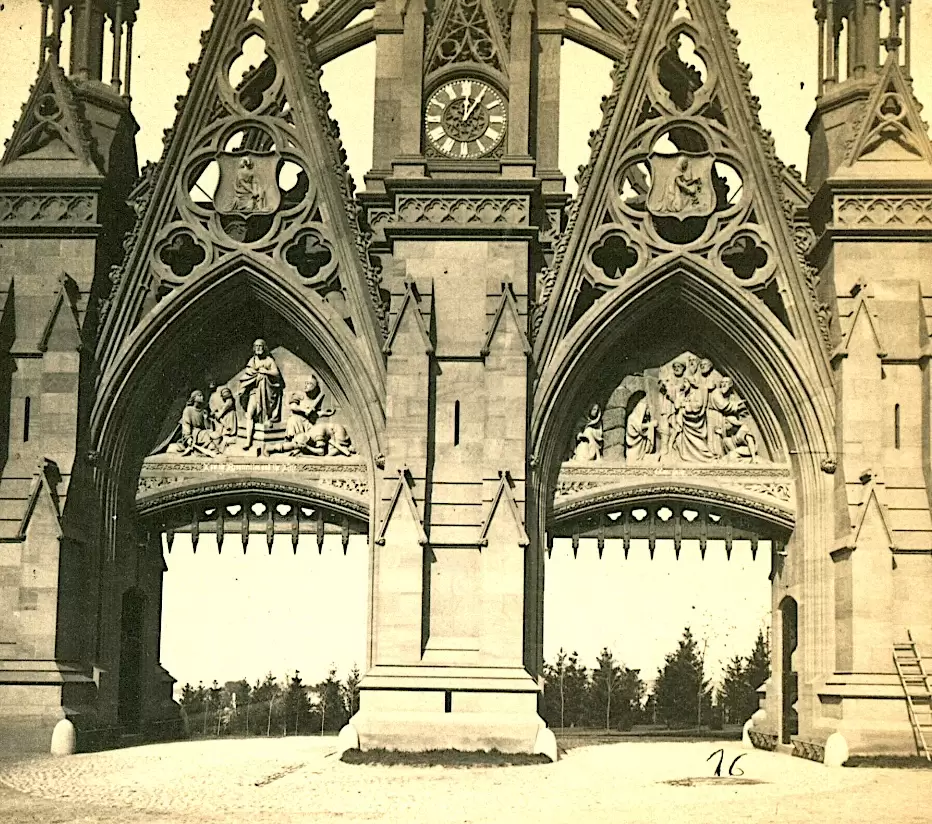
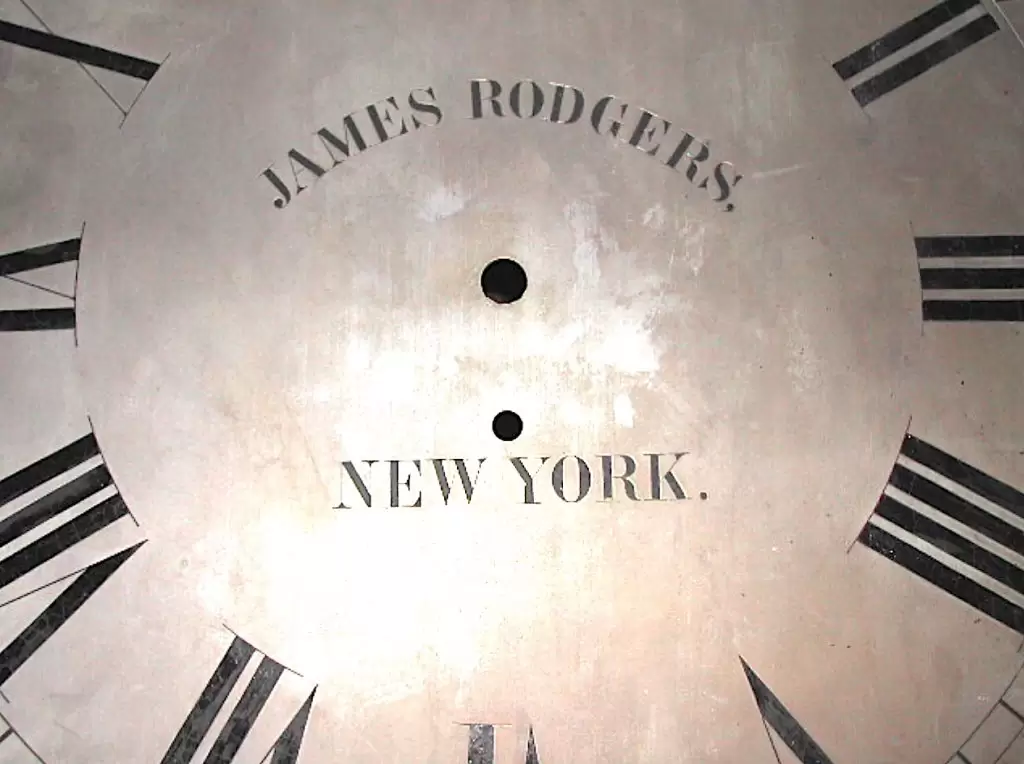
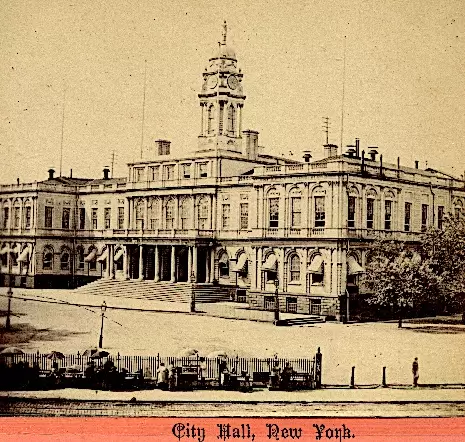
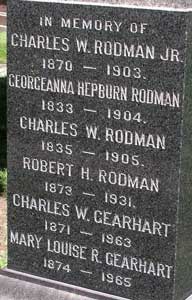
RODMAN, CHARLES WEBSTER (1835-1905). First lieutenant, 4th New York Infantry, Company K. A native New Yorker and a wool broker by trade, Rodman was 6′ tall with blue eyes, brown hair and a light complexion. He enlisted at New York City on May 2, 1861, as a second lieutenant, and was immediately commissioned into the 4th New York, also called Scott’s Life Guards. He was promoted to first lieutenant six days later (effective on July 1 of that year), and resigned on May 3, 1862.
In 1904, Rodman applied for an invalid pension, application 1,319,786, but it appears that it never was granted. He was a member of the Loyal Legion and the Freemasons. His brother-in-law, Leonard Fisher Hepburn (see), served in the 4th and the Signal Corps. He last lived in Queens, New York, where he was active in the Jamaica Club. His death was caused by gangrene. Section 47, lot 5562.
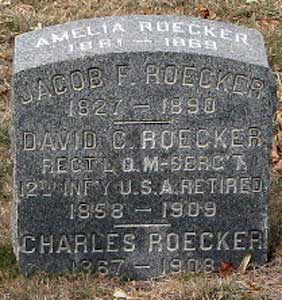
ROECKER (or ROIKER), JACOB F. (1827-1890). Private, 84th New York (14th New York) Infantry; 5th New York Veteran Infantry, Company H. After enlisting as a private at Brooklyn on September 16, 1862, Roecker, who was born in Germany, mustered into the 14th Brooklyn two days later, and transferred into the 5th Veterans on June 2, 1864. At some point during the War, he was wounded. He was discharged on June 5, 1865, at Washington, D.C. His last residence was on Atlantic Avenue in Brooklyn. Section 122, lot 17806, grave 47.
ROETH (or ROTH), LEONHARD (or LEONARD) (1824-1903). Private, 20th New York Infantry, Company C. Of German origin, Roeth served with the 20th New York. Further details about his service are not known. He last lived at 228 11th Street in Brooklyn. In 1903 Roeth succumbed to Bright’s disease. Section 207, lot 27873, grave 2.
ROFF, JR., GEORGE W. (1838-1906). Private, 9th New York Infantry, Company A. Roff, who was born in Stapleton, Staten Island, enlisted as a private at New York City on August 23, 1861, and mustered into the 9th New York that day. He was discharged by sentence of court-martial on an unknown date but returned in February 1863. As per his Draft Registration of June 1863, he is listed as a seaman living on Tillary Street in Brooklyn. According to the censuses of 1870 and 1880, he was employed as a boatman. The Veterans Census for Brooklyn in 1890 confirms that his military service. His last residence was 744 Prospect Place in Brooklyn. He died of angina pectoris. Section 135, lot 14964, grave 769.
ROGERS, ALBERT H. (1842-1916). Captain, 47th Regiment, New York State National Guard, Companies D and C. Enlisting for three months of service at Brooklyn, he was commissioned into Company D of the 47th Regiment as a first lieutenant on May 27, 1862, and mustered out on September 1. Promoted to captain on June 17, 1863, he was commissioned into Company C of the same regiment, and served for a month until he mustered out on July 23 at Brooklyn. He last resided in Sayville, Long Island. His death was caused by asphyxiation. Section 16, lot 14888, grave 1229.
ROGERS, CHARLES A. (1840-1865). Private, 13th Regiment, New York State Militia, Company G. Rogers enlisted as a private at Brooklyn on May 28, 1862, mustered into the 13th Regiment that day, and mustered out after three months on September 12 at Brooklyn. The May 8, 1865, edition of a local newspaper recounts a military funeral for the remains of Mr. Charles Rogers, “who died in consequence of disease contracted during the second 3 months’ campaign of the regiment.” The article noted that members of his regiment escorted his body to Green-Wood preceded by a band playing a funeral dirge. His last residence was at 43 St. Felix Street, Brooklyn, where he died from consumption. Section 67, lot 3041.
ROGERS, JR., EBENEZER H. (1843-1897). Private, 2nd Connecticut Infantry, Company B. Rogers, a native of Norwich, Connecticut, enlisted as a private on April 22, 1861, mustered into Company Rifle B of the 2nd Connecticut on May 7, at New Haven, and mustered out on June 26, 1861. The 2nd Connecticut was first stationed in Washington, D.C., and then was sent to Falls Church, Virginia. His application for an invalid pension was approved on April 7, 1862, certificate 9,671.
Rogers married Mary Sutherland in Brooklyn on September 4, 1881. On June 22, 1887, he mustered into the Clarence D. Mackenzie (see) Post #399 of the G.A.R.; at that time, he was living in Brooklyn and working as a bookkeeper. Rogers last lived at 340 Lewis Avenue in Brooklyn. His death was a suicide in Massapequa, Long Island. Although Mary Rogers, who is interred with him, applied for a widow’s pension in 1897, application 666,292, it was never certified. Rogers’s soldier records from Connecticut list 1925 as the year of Ebenezer Rogers’s death; that is incorrect—it was Mary Rogers who died that year. Section 180, lot 13912, grave 3.
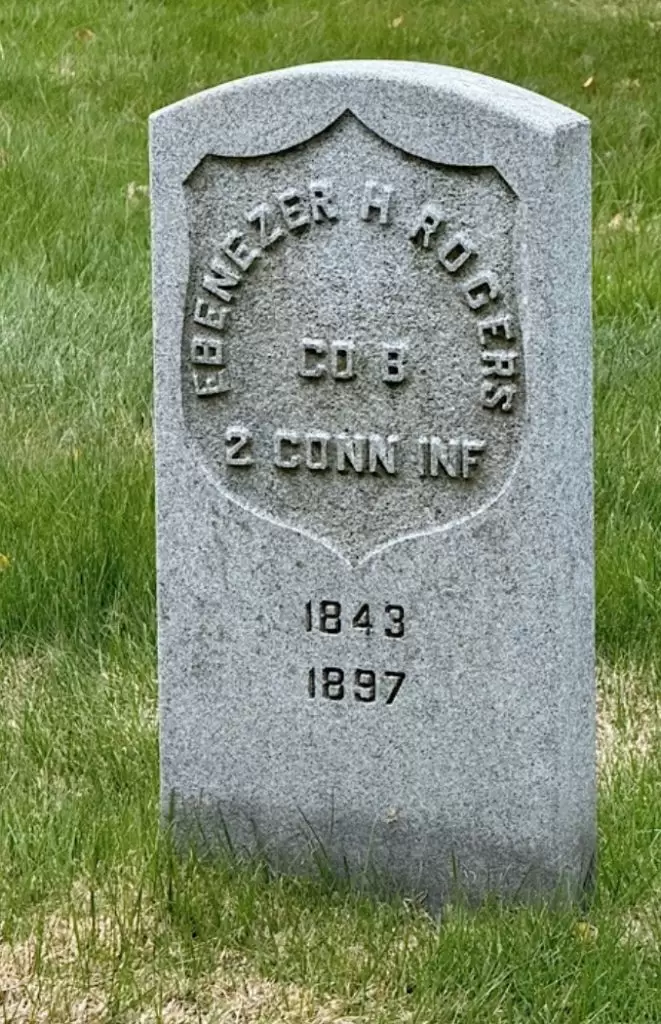
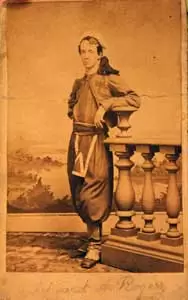
ROGERS, EDWARD AUGUSTUS (1841-1880). Private, 5th New York Infantry, Company C; 146th New York Infantry, Company B. After enlisting as a private at New York City on August 11, 1862, he mustered immediately into the 5th New York, also known as Duryee’s Zouaves. He transferred into the 146th New York on May 4, 1863, from which he was discharged on an unknown date. A descendant, who has letters written by his ancestor, notes that Rogers suffered from lice infestation that felt better after scratching. One letter also mentioned how the soldiers froze at the picket line at Fredericksburg, Virginia, when they feared that Confederate snipers would pick them off. A Freemason, his lodge presented him with a set a silver spoons upon his marriage in 1871. His death was attributed to “gummy tumor of brain.” Section 15, lot 17263, grave 188.
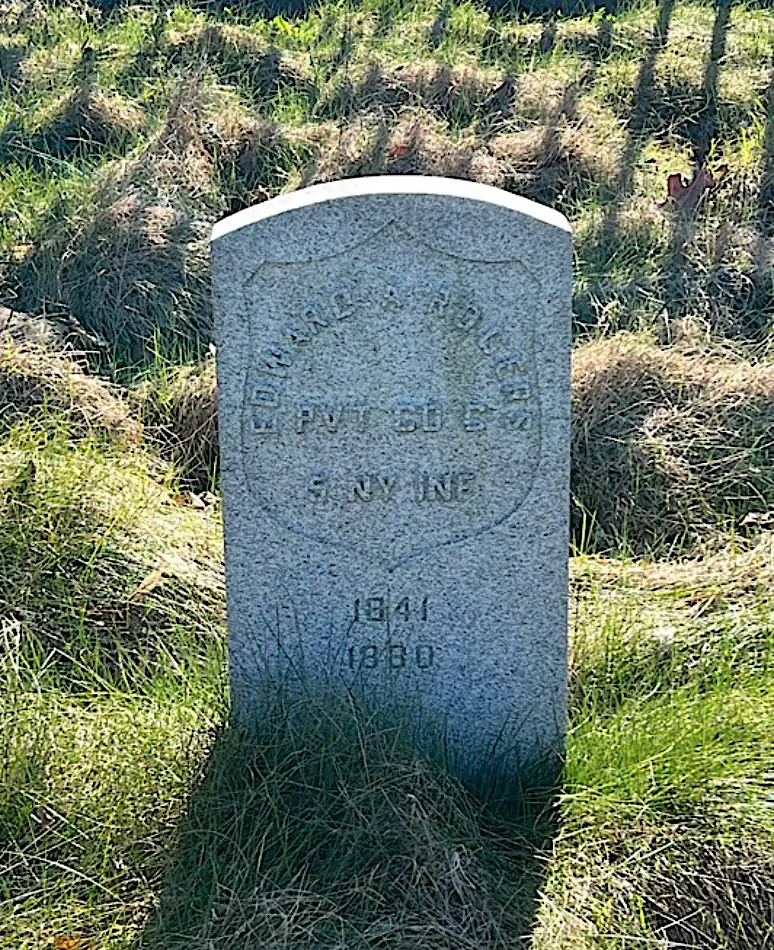
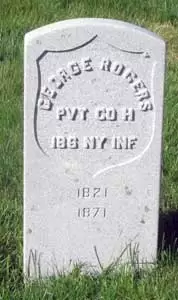
ROGERS, GEORGE (1821-1871). Private, 186th New York Infantry, Company H. Of Irish origin, Rogers enlisted as a private at Sacketts Harbor, New York, on September 9, 1864, mustered into the 186th the next day, and was hospitalized at some point during his service. He was absent when his company mustered out on June 2, 1865, at Alexandria, Virginia. He last lived at 104 Hopkins Street in Brooklyn. His death was attributed to drowning. Section 17, lot 17245, grave 1184.
ROGERS, GEORGE W. (1845-1924). First lieutenant, 3rd New York Infantry, Companies H and A; private, 9th New York Infantry, Company B. Born in New York City, Rogers enlisted as a private on September 23, 1862, at New York City, and mustered into the 9th New York the same day. On May 6, 1863, he was transferred to Company H of the 3rd New York. He was promoted to first sergeant on an unknown date and to first lieutenant upon his transfer to Company A on August 22, 1864. He was discharged on June 10, 1865, at Elmira, New York. In 1916, he applied for and received a pension, certificate 1,131,643. Rogers last lived at 128 Maple Street, Brooklyn. His death was caused by pneumonia. Cecille Rogers, who is interred with him, applied for and received a widow’s pension in 1925, certificate 959,509. Section 186, lot 34263.
ROGERS, HENRY (1845-1862). Private, 83rd New York Infantry, Companies L and B. Born in New York, Rogers enlisted as a private at New York City on September 4, 1861, and mustered that same day into Company L of the 83rd New York. He was transferred intra-regimentally to Company B on October 20, 1861. Rogers was wounded at the Battle of Antietam, Maryland, on September 17, 1862, and succumbed to his wounds on October 13, 1862. He last lived at 601 4th Street in New York City. Section B, lot 8575, grave 2.
ROGERS, HENRY E. (1828-1874). Private, 53rd New York Infantry, Company F; 132nd New York Infantry. Rogers, who was born in New York, enlisted on June 13, 1862, at New York City, as a private. On August 22, he mustered into the 53rd New York but was transferred the next month on September 10 into an unknown company of the 132nd New York. Further details about his service are unknown. His last residence was 90 Cliff Street in New York City. Section 121, lot 11189, grave 207.
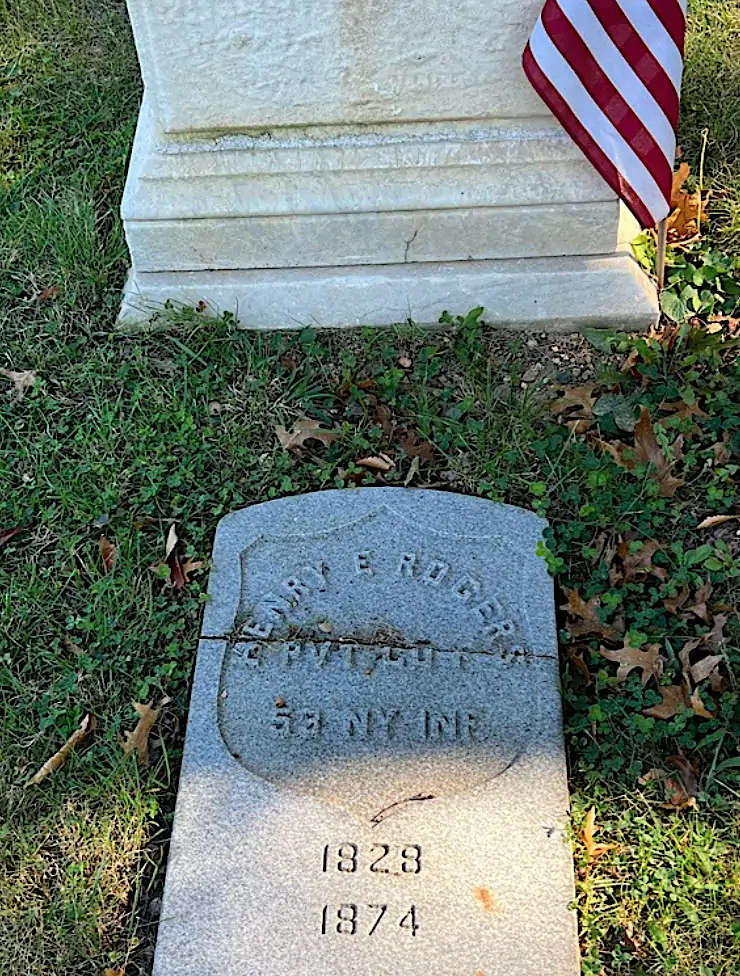
ROGERS, HIRAM H. (1844-1909). Private, 169th New York Infantry, Company I. A New Yorker by birth, he enlisted as a private at Troy, New York, on March 6, 1865, mustered immediately into the 169th New York, and mustered out with his company on July 19, 1865, at Raleigh, North Carolina. In 1890, he applied for and received an invalid pension, certificate 704,414. He last lived at 337 55th Street in Brooklyn. His death was caused by a fracture. Section 127, lot 16311, grave 338.
ROGERS, PARKER COLLINS (1821-1871). Private, 193rd New York Infantry. Rogers served in the 193rd New York. The company to which he was assigned and other details of his service are unknown. He last lived at 777 Seventh Avenue in Manhattan. Section 127, lot 17931, grave 363.
ROGERS, THOMAS (1836-1908). Sergeant, 127th New York Infantry, Company F. He enlisted on July 8, 1862, at New York City, and mustered into the 127th New York two months later on September 8. His last residence was on Locust Street in Queens. Section 186, lot 19758.
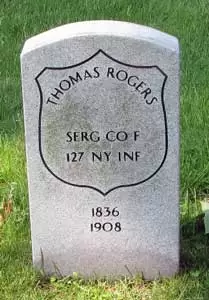
ROGERS (or RODGERS), WILLIAM B. (or R.) (1842-1862). Private, 61st New York Infantry, Company F. Born in Philadelphia, Pennsylvania, he enlisted at New York City as a private on September 23, 1861, mustered in the next month on October 3, and was killed by a gunshot wound at Antietam, Maryland, on September 17, 1862. He was interred at Green-Wood on December 19, 1894. Section 140, lot 28375.
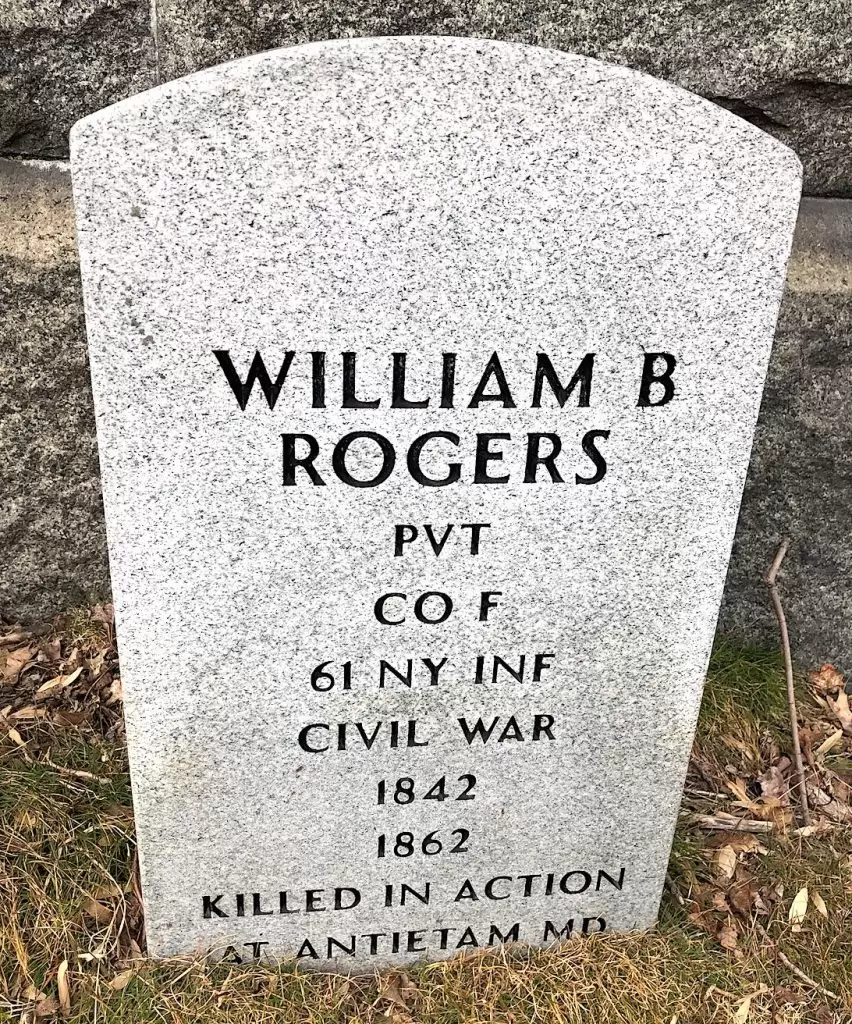
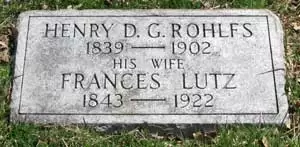
ROHLFS, HENRY D. G. (1839-1902). Drum major, 28th New York Infantry; or private, 31st New York Light Artillery. Born in Germany, he may be the soldier who enlisted for three months in 1861 as a drum major in the Field and Staff of the 28th New York Infantry. Alternatively, he may be the soldier who enlisted on August 20, 1861, at New York City, giving his age as 25 years, mustered into the 31st New York Light Artillery as a private that day, and mustered out on October 14, 1861, at Fort Monroe, Virginia. It is also possible that Rohlfs re-enlisted after his first service. He last lived at 145 Clinton Avenue in Brooklyn. Section 107, lot 12650.
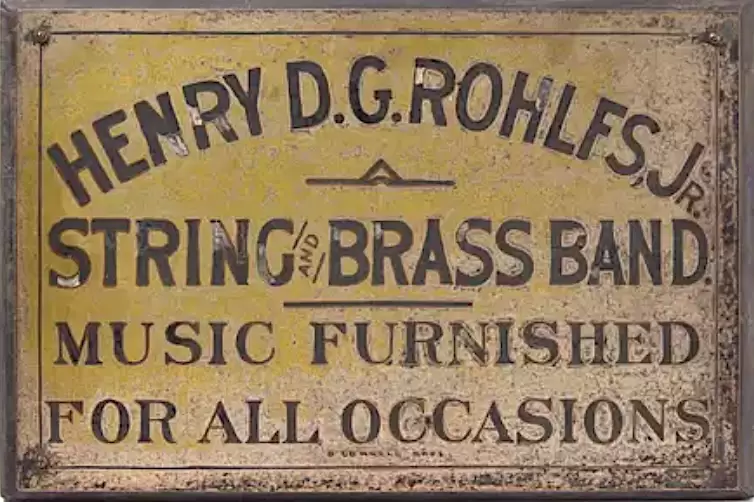
ROLL, GEORGE (1814-1895). Private, 39th New York Infantry, Company E. Of German birth, he enlisted and mustered into the 39th on November 24, 1863, and was discharged for disability on February 27, 1864, at Stevensburg, Virginia. His last address was 35 7th Street in New York City. Section 33, lot 5498, grave 3.
ROLLINS, HUGH (1832-1882). Corporal, 79th New York Infantry, Company E. Born in Limerick, Ireland, Rollins enlisted as a private at New York City on May 13, 1861, and mustered into Company E of the 79th New York as a corporal on May 27. His muster roll notes that he was in Harewood Hospital on September 7, 1862. His muster roll also reports that he was dropped from the rolls in error at another time when he was hospitalized. At some point, he was reduced to ranks. He mustered out with his company on May 31, 1864, at New York City. The census of 1880 indicates that he was living with his wife and two children in Meriden, Connecticut, where he worked as a glass engraver at a glass works. He last lived in Meriden, Connecticut. His death was attributed to diarrhea. Section 63, lot 14802.
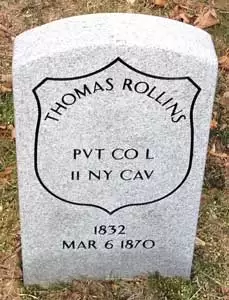
ROLLINS, THOMAS (1832-1870). Private, 11th New York Cavalry, Company L. Born in England, he enlisted as a private at Washington, D.C., on October 30, 1862, and mustered in the same day. He served until he mustered out at Gayoso General Hospital at Memphis, Tennessee, on June 6, 1865. His last residence was in Flatbush, Brooklyn. Rollins died of consumption. A marble Veterans Administration stone was ordered for him early in the 20th century. Section 115, lot 13536 (Soldiers’ Lot), grave 113.
ROLLSTON (or ROLSTON), GREER (or GRIER, GRUE) (1817-1882). Private, 36th New York Infantry, Company I. Born in Ireland, Rollston immigrated to the United States in 1845. The 1850 census indicates that he was married, living in New York City and employed as a box maker. During the Civil War, he enlisted as a private at Riker’s Island in New York City on July 4, 1861, mustered into the 36th New York, and mustered out with his company at New York City on July 15, 1863. The 1870 census shows him living in New York City with his adult children and working as a carpenter. He last lived at 534 West 43rd Street in New York City. His death was attributed to apoplexy. Section ?, lot 5499, grave 2085.
ROMAINE, JOHN H. (1830-1910). Private, 12th Regiment, New York State Militia, Company D. Romaine, a native of New York City, served for three months when the 12th Regiment was activated in 1861. In 1908, his application for a pension was granted, certificate 1,074,964. He last lived at 150 Penn Street in Brooklyn. He died of chronic bronchitis. Section 99, lot 6374.
ROMAINE, WILLIAM H. (1835-1908). Captain, 174th New York Infantry, Company D; private, 7th Regiment, New York State Militia, Company E. Romaine enlisted at New York City on April 17, 1861, to serve 30 days with the 7th Regiment, mustered in on April 26, and mustered out with his company at New York City on June 3. He enrolled again at New York City on May 25, 1862, to serve three months in the same regiment and company, then part of the New York State National Guard, mustered in on June 19, and mustered out with his company on September 5 at New York City. On October 20, 1862, he was commissioned into the 174th New York as a captain, served with General Banks in Louisiana, was at Port Hudson and in the Red River Expedition there, and was discharged on August 20, 1863. He was granted an invalid pension in 1895, certificate 915,124. His last residence was on Fairview Avenue in Jersey City, New Jersey. After his death from exhaustion, Caroline Romaine, who is interred with him, applied for and received a widow’s pension in 1908, certificate 666,262. Section 198, lot 29036.
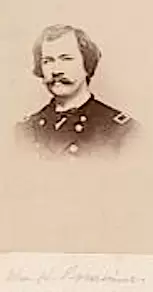
ROME, WILLIAM M. (1842-1901). First lieutenant, 28th Regiment, New York State National Guard, Company G. Rome, a native of Annan in Dumfries, Scotland, immigrated to the United States in 1847. As per the census of 1860, he lived with his family in Brooklyn and worked as a clerk; his mother died in 1861. During the Civil War, Rome enlisted as a first lieutenant on August 1, 1864, was commissioned into Company G of the 28th Regiment on August 23 for its 100-day activation, and mustered out at New York City on November 13, 1864.
The New York State census of 1865 reports that Rome lived with his father and siblings in Brooklyn and was employed as a clerk. He married Sarah Jane Johnston on November 25, 1865; as per records of the Dutch Reformed Church, their first child, Mary Elizabeth, who was born in 1866, was christened at the Middle Church. According to the 1880 census, Rome was married with children, lived at 108 Bridge Street in Brooklyn and worked as a clerk. The 1890 Veterans Census confirms Rome’s Civil War service and notes that he lived at 19 Willoughby Street in Brooklyn. On July 5, 1887, he mustered into the Clarence D. Mackenzie (see) Post of the G.A.R.; he noted that he lived in Brooklyn and worked as a collector. As per the census of 1900, he lived at 226 Clermont Avenue in Brooklyn in a house that he owned, had been married to his wife Sarah for 34 years, was a naturalized citizen, and was a government bond clerk. He last lived at the Clermont Street address. His death was attributed to heart disease. Sarah Rome, who is interred with him, applied for and received a widow’s pension in 1902, certificate 685,138. His remains were moved to the current location on September 7, 1907. Section 162, lot 15527.
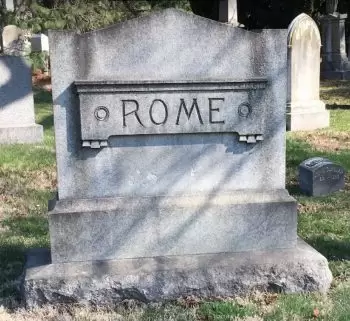
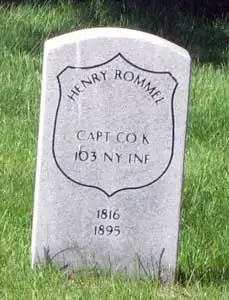
ROMMEL (or ROMEL), HENRY (1816-1895). Captain, 103rd New York Infantry, Company K. Of German birth, he enlisted as a captain at New York City on November 2, 1861, was commissioned into the 103rd on February 7, 1862, and was discharged for disability on September 26, 1862, at Washington, D.C. His last address was 634 East 141st Street in Manhattan. He died of phthisis (tuberculosis). In 1895, his widow, Catherine Rommel, received a pension, certificate 225,766. Section 2, lot 5499, grave 636.
RONZONE, SILVIO J. B. (1836-1873). Second lieutenant, 39th New York Infantry, Companies A, C, and K. Originally from Italy, Ronzone enlisted as a private at Washington, D.C., in 1861 and mustered into Company A of the 39th New York, known familiarly as the Garibaldi Guard on July 1. On July 7, he rose to corporal and was transferred to Company C (a company formed from Company A). Subsequently, he was promoted to sergeant on June 15, 1862, and transferred to Company K where he was commissioned as a second lieutenant on August 24, 1862. He was discharged on December 17 of that year. His last residence was 60 Pierrepont Street in Brooklyn. Ronzone died of tuberculosis meningitis. In 1881, his wife applied for and received a widow’s pension, certificate 192,597. His child received a minor’s pension, certificate 195,212. Section 17, lot 17245, grave 1049.
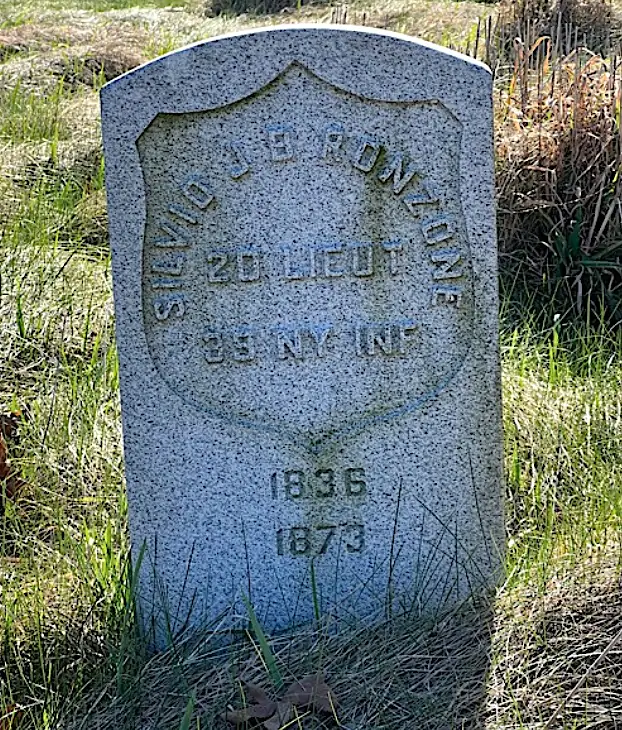
ROOF, MOSES C. (1832-1887). Corporal, 152nd New York Infantry, Company A. A laborer by trade, Roof was 5′ 6″ tall with blue eyes, brown hair and a light complexion. After enlisting as a corporal at Little Falls, New York, on September 6, 1862, Roof mustered into Company A of the 152nd New York on October 14, and was discharged for disability on December 27, 1862, at Washington, D.C., from Patent Office Hospital. According to his discharge papers, he was suffering from hemorrhoids.
Roof last lived at 186 12th Street in Brooklyn. His death was attributed to drowning in New York Harbor. A newspaper article about his demise noted that he was the owner and captain of the Flagship and Constitution, canalboats that delivered coal to the White Star and Morgan Line steamers. It appeared that he fell into the East River when he was trying to board his vessels in the darkness on the morning that he disappeared. His body was found days later by men who had been employed to drag the waters for his remains. In 1891, his wife applied for and received a widow’s pension, certificate 352,601. Section 17, lot 17245, grave 362.
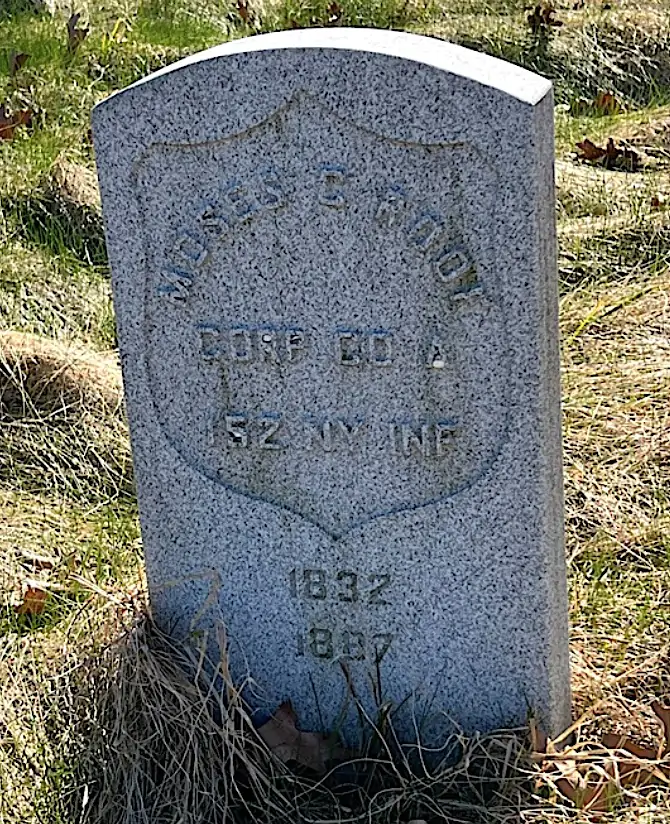
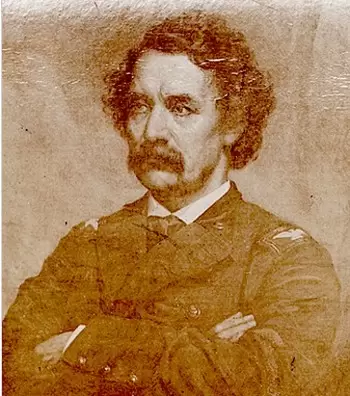
ROOME, CHARLES (1812-1890). Brigadier general by brevet; colonel, 37th Regiment, New York State National Guard. A native New Yorker, Roome joined his father’s thriving mercantile business as a clerk before accepting a position as an assistant engineer with the Manhattan Gas and Light Company in 1837. He rose to chief engineer five years later and became president of the company in 1855.
When the Civil War began, Roome helped raise the 37th Regiment of the New York State National Guard, ultimately leading it as its colonel. At age 49, he enlisted at New York City on May 29, 1862, was commissioned into the 37th New York’s Field and Staff as its colonel that day, and mustered out on September 2 of that year at New York City. He returned to the same regiment on June 24, 1863, commanded the 37th at the skirmish at Sporting Hill, Pennsylvania, on June 30 and mustered out the next month on July 22 at New York City. He was brevetted to brigadier general on March 13, 1865, “for faithful and meritorious services.”
After the War, Roome returned to Manhattan Gas and Light as president, a position he held until shortly before his death. Active in the Freemasons after 1866, he held numerous local, regional and national leadership roles including Grand Master of the Masons of New York State, Supervisor of the Knights Templar of New York, New Jersey and Pennsylvania (1875), and Grand Master of the Knights Templar in 1886. His leadership in the Masonic organization was recognized by numerous testimonials from fellow members, and gifts including a chronometer and engraved resolutions. In his obituary, fellow Freemasons praised him for his generosity, charitable nature, and earnestness. Roome last lived in New York City where he succumbed to cirrhosis of the liver. Section 69, lot 3626.
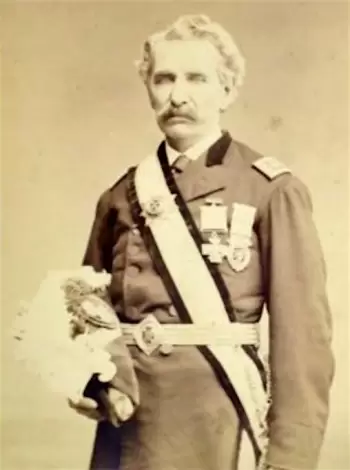
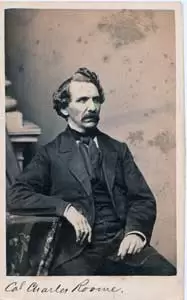
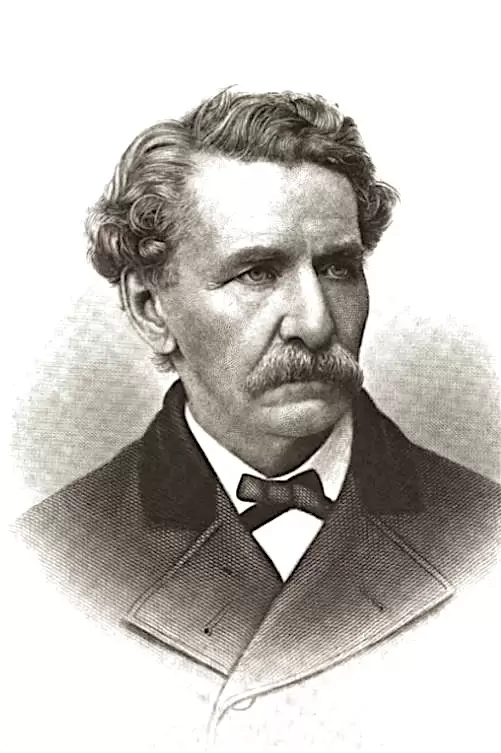
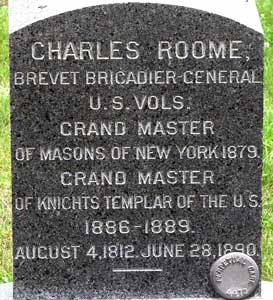
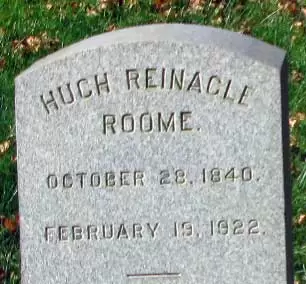
ROOME, HUGH REINAGLE (1840-1922) Private, 7th Regiment, New York State National Guard, Company B. New York City-born, Roome enlisted there as a private in 1863 and served 30 days with the 7th New York National Guard, mustering out at the expiration of his enlistment. He was most likely the brother of James Roome (see). His last residence was 127 Midland Avenue in Arlington, New Jersey. His death was attributed to acute dilatation of the heart. Section 92, lot 10696.
ROOME, JAMES W. (1836-1875). Private, 7th Regiment, New York State Militia, Company B. A native of New York, Roome served as a private in the 7th Regiment when it was activated for 30 days in 1861. He returned to the same regiment and company for 30 days in 1863 when it was part of the New York State National Guard. He was likely the brother of Hugh Reinagle Roome (see). He last lived in Fordham, New York, where he died from a skull fracture. Section 92, lot 10696.
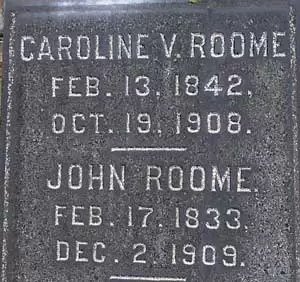
ROOME, JOHN (1833-1909). Private, 57th New York Infantry, Company A. A New York City native, he enlisted there as a private on September 14, 1861, mustered immediately into the 57th New York, and deserted on August 30, 1862, at Centreville, Virginia. His last residence was 446 Dean Street in Brooklyn. His death was caused by pneumonia. Section 182, lot 14821.
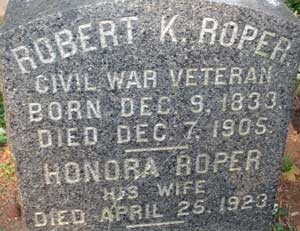
ROPER, ROBERT KEYNES (1833-1905). Seaman, United States Navy. Born in Dorset, England, where he served as an apprentice in the merchant marine, Roper enlisted in the United States Navy as an able seaman at New York on October 7, 1861, on the USS North Carolina. At the time of enlistment, he recorded his occupation as sailor. He was initially assigned to the bark USS Braziliera in the North Atlantic Blockading Squadron. He was 5′ 4½” tall with grey eyes, brown hair and a fair complexion. On either December 31, 1861, or January 1, 1862, he was transferred to the frigate USS Congress.
In late January or early February 1862, at Newport News, Virginia, Roper fell down a snow-covered hatch. According to his affidavit for an invalid pension, he was injured in the small of his back, sapping his strength and leaving a permanent mark. Unable to get up from his hammock the next morning, he was carried to the ship’s hospital, where he spent about six weeks.
On March 8, 1862, not long after Roper’s release from sick bay, the Congress came under attack and was set ablaze by the ironclad CSS Virginia (which had been the USS Merrimack before its capture and refitting) at Hampton Roads, Virginia. The following day, the Merrimack was engaged by the USS Monitor while the Union ironclad protected the grounded and badly damaged USS Minnesota, to which Roper had been reassigned upon the sinking of the Congress the previous evening. This engagement was the iconic “Battle of the ironclads.” After serving about a month on the Minnesota, Roper was reassigned to the Braziliera, serving until April 20, 1863. He was discharged from the Navy on the USS Princeton at Philadelphia on May 15, 1863.
Roper is listed in a New York directory as “mariner” (date unknown) and at the time of his second marriage in 1867, but listed his occupation as watchman when he applied for a pension from the Navy in 1890 in which he cited a disability from weakness in the arm and back. The pension was later approved under certificate 17,953. In a subsequent pension affidavit in 1904, he was working as a laborer and described himself as 143 pounds with grey hair and eyes and India ink tattoos on his right forearm. According to his death certificate, he worked for the New York City Water Works. He last lived at 679 Degraw Street in Brooklyn. Hannah (Honora) Roper, his second wife who is interred with him, received a widow’s pension shortly after his death, which was caused by sarcoma, certificate 17,691. Section 86, lot 31217, grave 214.
ROSBOTHAM, ROBERT (1841-1901). Landsman, United States Navy. Of Irish origin, Rosbotham enlisted as a landsman for one year on March 8, 1864, at the United States Naval Rendezvous at New York City. A laborer, he was 5′ 2″ tall with hazel eyes, brown hair, a fair complexion and a “pockmarked face.” He served on the USS Pocahontas, USS Itasca, and the USS Bienville.
On October 6, 1876, Rosbotham became a naturalized citizen. The 1888 Brooklyn Directory lists him as a bookkeeper living at 182 Prospect Avenue in Brooklyn. His application for a pension from the United States Navy was approved, certificate 26,861. Rosbotham last lived at 204 53rd Street in Brooklyn. The cause of his death was cancer. His wife applied for and received a widow’s pension, certificate 15,499. Section 6, lot 20118, grave 483.
ROSCHER, CHARLES (1833-1894). Private, 173rd New York Infantry, Company E. A native of Germany, Roscher enlisted at Brooklyn as a private on September 6, 1862, mustered into the 173rd on October 30, 1862 and was discharged from military service on October 18, 1865, at Savannah, Georgia. The 1890 Veterans Schedule confirms his military service. In 1890, he applied for and received an invalid pension, certificate 695,941. He last lived at 168 President Street in Brooklyn. His death was attributed to mitral regurgitation. In 1895, Eliza Roscher applied for and received a widow’s pension, certificate 401,425. Section 135, lot 27263, grave 668.
ROSE, DANIEL EUGENE. (1845-1927). Corporal, 43rd Ohio Infantry, Company H. A native of Oberlin, Ohio, Rose enlisted on November 28, 1861, as a private. On December 10, he mustered into Company H of the 43rd Ohio, was promoted to corporal on an unknown date, and was discharged from military service on January 2, 1865. In 1907, his application for a pension was granted, certificate 1,145,242. His last residence was 598 2nd Street in Brooklyn. Shortly after his death from arteriosclerosis in 1927, his wife applied for and received a widow’s pension, certificate A-1-11-28. Section 93, lot 6520.

ROSER, JACOB F. (1834-1896). Private, 9th Pennsylvania Reserve Infantry. Born in Germany, Roser served as a private with the 9th Pennsylvania Reserve Infantry (also known as the 38th Volunteers). He also had service in the U.S. Army General Service. His last address was 202 22nd Street in Brooklyn. Roser died of apoplexy. Section 135, lot 14964, grave 609.
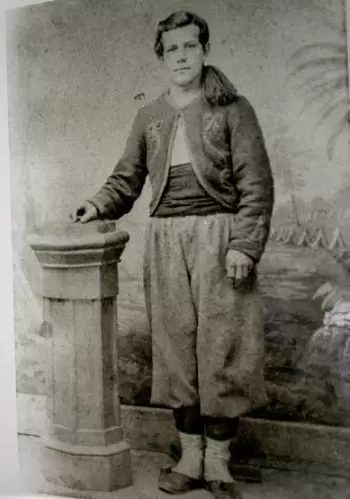
ROSS, ALBERT CHARLES (1843-1925). Private, 5th New York Infantry, Company A; 146th New York Infantry, Company K. Ross enlisted as a private at New York City, his birthplace, on August 25, 1862. A hat-presser by trade, he was 5′ 6¼” with hazel eyes and dark brown hair. Originally sent to the 165th’s camp on Staten Island, he was then sent to the 5th New York where he mustered that day, and served with the regiment until he was transferred into the 146th New York on May 4, 1863. He injured his arm and ankle a month later on June 23, was hospitalized for an unspecified reason in October 1863, returned to his regiment on February 25, 1864, and then injured his arm and hand after falling from his horse on May 11, 1864. He mustered out on June 3, 1865, at Alexandria, Virginia.
Returning to the hat-making business after the War, Ross was employed as a dyer and bleacher. He was also a member of the 5th Veterans Association. Ross applied for an invalid pension in 1897, certificate 1,114,947. His last residence was 312 Decatur Street in Brooklyn. He died of cardiac disease. Section 183, lot 20262.
ROSS, CHARLES H. (1845-1862). Private, 5th New York Infantry, Company E. A New Yorker by birth, he enlisted there as a private on July 19, 1861, and mustered into the 5th New York three days later. After being wounded and captured at the Battle of Second Bull Run, Virginia, on August 30, 1862, he was paroled on September 1. Admitted to Carver Hospital in Washington, D.C., the next day, his right leg was amputated on September 23, infection set in and he succumbed to his wounds on October 7. Originally buried in lot 4196, grave 868, his remains were moved to the current location on March 24, 1866. Section 164, lot 16473.
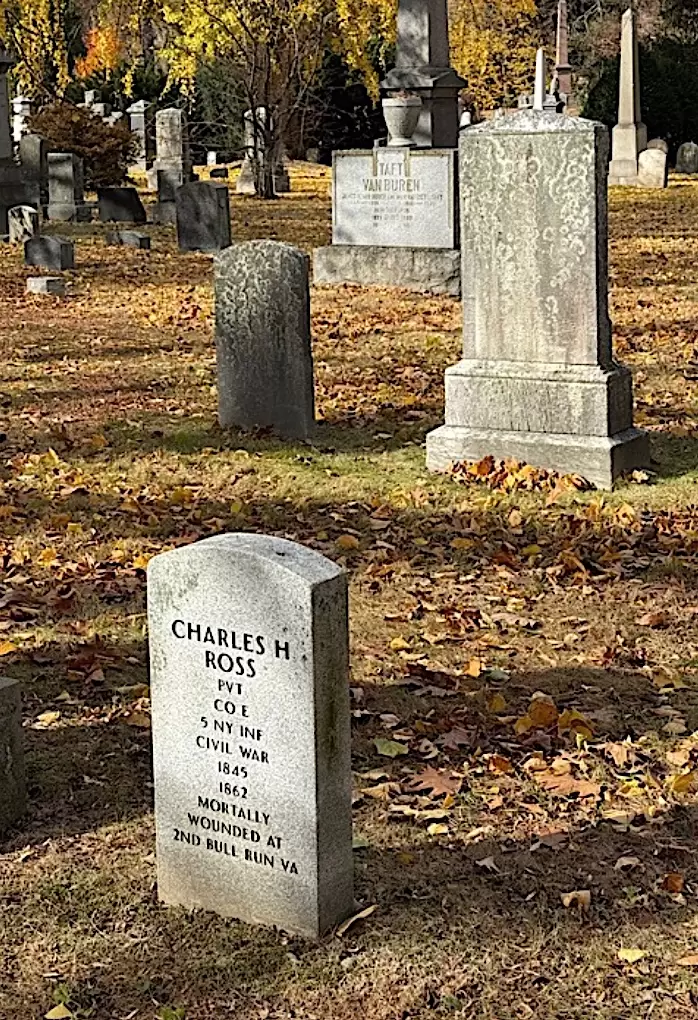

ROSS, EDWARD (1836-1862). First lieutenant, 7th Infantry, United States Army. Born in Long Island, New York, Ross was a cadet at the United States Military Academy from July 1, 1854-February 2, 1855. He enlisted as a second lieutenant on April 26, 1861, was commissioned into the 7th Infantry of the United States Army that day, and was promoted to first lieutenant a month later on May 23.
Brigadier General D. H. Rucker, United States Army, in his field report describing the actions from April 20-July 7, 1862, wrote, “On the 20th day of April I directed Lieutenant [Edward] Ross to proceed to Aquia Creek, Va., for the purpose of establishing a depot of supplies at that point. Under his supervision warehouses were erected and arrangements commenced for the receipt, handling, and protection of stores; and the U. S. Military Railroad Department having constructed wharves, re-laid the track, and rebuilt the bridges on the road from Aquia Creek to Fredericksburg…” He took sick there in July and died of typhoid fever in Washington, D.C., on July 23, 1862. Section 95, lot 5736.
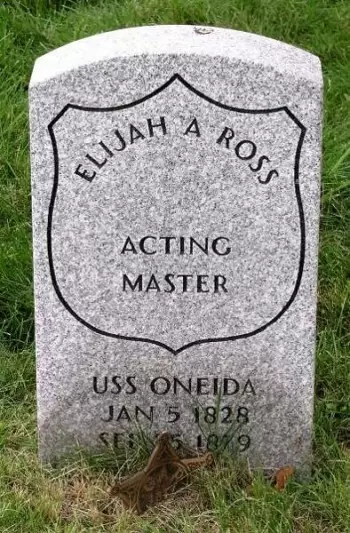
ROSS, ELIJAH A. (1828-1879). Acting master, United States Navy. Born in North Yarmouth, Maine, Ross was registered as a member of the American Ship Masters’ Association on December 4, 1861, and served as acting master in the Navy aboard the USS Oneida from the following December 28 until August 1864. During that period, the Oneida was assigned to the West Gulf Blockading Squadron, under the command of Admiral David Farragut, during the blockade of Mobile Bay, Alabama, and New Orleans, Louisiana. In a significant Union victory, the Oneida, commanded by Captain Samuel Phillips Lee, along with three other Union ships, pursued and defeated Confederate gunboats in April 1862 on the Mississippi River near New Orleans. The only blemish on the day was severe damage to the Oneida during the engagement. On October 9, 1862, Ross provided testimony at a court inquiry into the conduct of the Oneida’s then commander, George Henry Preble, for failing to prevent the Confederate steamer Oreto from running the blockade of the harbor of Mobile. The inquiry resulted in Preble’s dismissal, which was later reversed by President Lincoln. Ross tendered his resignation from the Navy on August 11, 1864, due to heart problems and rheumatism, and it was accepted by Gideon Welles, Secretary of the Navy.
In 1878, Ross’s occupation was listed as stevedore on his marriage certificate. Admitted to the Home for Sailors in Snug Harbor, Staten Island, with a disability of partial paralysis, Ross died there just over a year later of cerebral apoplexy. His widow, Esther Ross, applied for a pension in 1892, certificate number 9,069. In June 2003, the Sons of Union Veterans of the Civil War, an organization created as a successor to the G.A.R., dedicated a new veteran’s headstone for Ross at Green-Wood. A G.A.R. star is placed in front of the stone. Section 15, lot 17263, grave 520.
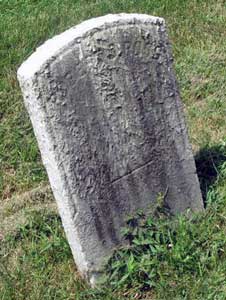
ROSS, JAMES D. (or ROBERT D.) (?-1890). Private, 4th New York Heavy Artillery, Company F; unknown rank, United States Navy. As per his pension records, he was also known as Robert D. Ross. Using that alias, he enlisted as a private at New York City on August 18, 1861, served in the 4th New York Heavy Artillery, and was discharged on January 15, 1865.
According to Marie Ross’s 1891 application for widow’s pension from the Navy, Robert Ross re-enlisted in the Navy on March 29, 1865, and was discharged on July 13, 1868. That pension application also indicates that he re-enlisted in the Navy under the name of James D. Ross (date unknown) and was discharged in April 1890. She also applied for a widow’s pension for her husband’s service in the Artillery in 1891, application 524,416, but that request was transferred to the U.S. Navy; her pension from the Navy was awarded under certificate 12,254. His death was caused by Bright’s disease. A badly-eroded marble gravestone marks his burial site, probably placed there circa 1900. Section 206, lot 21347 grave 698.
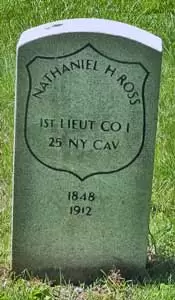
ROSS, NATHANIEL H. (1848-1912). First lieutenant, 25th New York Cavalry, Companies B and I. After enlisting at New York City as a private on December 1, 1863, Ross mustered into Company B of the 25th New York Cavalry. He was promoted to first lieutenant on September 29, 1864, effective upon his transfer to Company I on November 11, and mustered out on June 27, 1865, at New York City. A superintendent of construction for the Otis Elevator Company in civilian life, he was a founder of the Cushing Post #231 of the G.A.R. In 1892, he received an invalid pension, certificate 870,704. He last resided on 4th Street in Brooklyn. He died of acute cardiac dilatation. Section 186, lot 18146.
ROSS, WILLIAM JOHN (1833-1886). Second lieutenant, 84th New York (14th Brooklyn) Infantry, Company H; private, 5th New York Veteran Reserve Infantry, Company K. Originally from the West Indies, Ross enlisted at Brooklyn as a private on August 20, 1862, and mustered into Company H of the 14th Brooklyn on that date. Ross was promoted to second lieutenant on April 13, 1864, but he did not muster in that rank. On June 2, 1864, he transferred into Company K of the 5th New York Veterans as a private. He was listed as a prisoner of war, place unknown, and was paroled at Camp Parole at Annapolis, Maryland, on June 19, 1865, the same day that he mustered out of service. His last residence was 1029 Myrtle Avenue in Brooklyn. Ross died of phthisis. Section 24, lot 7983, grave 3.
ROSSWELL, WILLIAM H. (1836-1896). First lieutenant, 9th New York Infantry, Companies I and H. Rosswell enlisted at Rikers Island as a private on May 27, 1861, and mustered into Company I of the 9th New York on the same day. He was promoted to first lieutenant three days later. On February 3, 1862, he was transferred to Company H, and was discharged at Roanoke Island, North Carolina, on February 15, 1862. His last residence was 9 Debevoise Place in Brooklyn. His death was attributed to aortic insufficiency. Section 146, lot 25170.
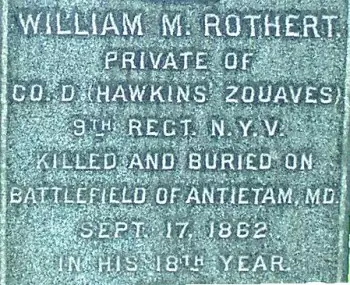
ROTHERT, WILLIAM (1841-1862). Private, 9th New York Infantry, Company D. Rothert is not buried at Green-Wood; the cenotaph to him at the cemetery honors his memory. Rothert was born in New York City. His birth year is unclear based on his cenotaph which differs from census records and the final soldier papers. The 1850 census indicates that he was living in New York City with his parents and younger sister; William was attending school. As per the 1855 New York State census, 10-year-old William was living in New York City with his parents, three younger sisters and two boarders.
After enlisting at New York City on April 23, 1861, he mustered into the 9th New York the next month, on May 4. As per his muster roll, Rothert was paid by New York State $3.96 for his service from April 23 through May 3, 1861. He was killed on September 17, 1862, at the Battle of Antietam, Maryland.
As per the list of his clothing, description and final statement, Rothert was 19 years old, 5′ 6½” tall with gray eyes, dark hair and a medium complexion. That document, signed by the first lieutenant of his company, notes that he was a clerk, had signed up to serve two years and was last paid on June 30, 1862, with monies due to the date of his death. In addition, he owed the United States 87 cents for clothing; other personal effects were sent home.
Rothert’s diary, in which he records experiences serving in Virginia and sketches of his Zouave uniform, is at the New-York Historical Society. Harold Holzer, in his The Civil War in 50 Objects, describes that 83-page diary as “one of the most remarkable of all Civil War journals.” Kept form August 1861 into July 1862, Holzer describes it as a meticulous daily account, “providing an important record of both routine life in camp and the jolting horror of battle action.” Holzer notes:
On the eighty-three pages on which he wrote his surviving entries and drew his little pictures, Rothert recorded meticulous details about daily weather conditions and shed light on the often boring routine of army life. Although at first he saw little action himself, he did get to see a famous general or two, spied an occasional rebel, nearly drowned, made some mischief, endured mild punishment for his transgressions, went hungry, marked his twentieth birthday amid death and a freak accident in camp, and witnessed the arrival of escaped slaves seeking safety and freedom in the Union lines—fugitives he dismissed with racial epithets typical of the time. The summer heat was brutal, the fall winds bitter, the marches exhausting, the physical labor tiresome, and the rumors rife and often exaggerated, but Rothert’s occasionally banal notations open a valuable window onto the life of a volunteer soldier on coastal duty during the first summer and fall of the Civil War—as the following excerpts show. And they culminate with a gripping account of Rothert’s first battle action during General Ambrose E. Burnside’s successful expedition to set up a Union stronghold along the coast of North Carolina. The history books show that Burnside succeeded in capturing Roanoke Island, where he seized thirty-two heavy guns and twenty-six hundred prisoners, then took New Berne, Beaufort, and Fort Macon. For these successes, Burnside earned promotion to major general. For his part, the Zouave private William Rothert gained no such acknowledgment—only the experience of a lifetime. As they say, he “saw the elephant.”
Holzer quotes at length from young Rothert’s diary:
1861
Camp Butler
Thurs Aug 1st [A]ll the liquor was thrown away by order of Gen But[ler]
Friday Aug 2nd Very fine and pleasant, warm eleven shots were fired at the pickets none of them taking effect.
Thursday Aug 8. Warm and pleasant expecting an attack 7,500 Rebels are at Little Bethel.
Monday Aug 12. Companies A and I have been so bad that the Colonel refused to give them anything to eat until they will do their duty.…Early at 3 o’clock this morning 4 niggers came from the other side of the river in a sail boat
Saturday Aug 24. Pleasant, a few rebels were seen scouting around last night. I was on the outer picket with a sergeant. Saw two rebel horsemen we both fired and they galloped off one of them was wounded tracks of blood seen on the leaves.
Camp Wool 3 miles from Fort Hatteras H[atteras] I[nlet]. N.C.
Thursday Sept 12 Building barracks
Saturday Sept 14 Had a little skirmish with about 200 cavalry none lost
Wednesday 18. Warm very heavy rain during the evening great trouble with mosquitoes
Thursday Sept 19. Warm the report is that 14000 men are to attack us
Saturday Sept. 21. Warm took 2 prisoners colored from mainland
Sunday Sept. 29 Pleasant Divine Service
Friday Oct. 4 Very warm the whole battalion started on a march this afternoon at 4 o’clock for the Light House where there were 1500 rebels landed marched until 11 o’clock when we bivouacked
Saturday Oct. 5 Got up at 3 o’clock and continued our march we arrived at the Light House but found no rebels they had retreated so we marched on our way back to camp where we reached at 9 o’clock in the evening a very tiresome sandy march
Monday Oct 7 Warm the rebels committing outrages on the inhabitants
Thursday Oct 17. Rainy buried a member of Co. G. a great many sick.
Sunday Oct 27 Chilly the party of the Indiana Regt were attacked last night
Tuesday Oct 29 Cold very heavy wind capsized in a boat had to swim a mile and a half to shore
Monday Nov 11 Steamer arrived giving the news that Charleston Beaufort and other places were taken Pleasant [The Union captured Beaufort, South Carolina, from its base at Port Royal on November 9.]
Tuesday Nov. 12 My birthday one of the member[s] of Co A died last night. One of the members of Co K Geo Bowers while attempting to draw a charge out of his musket accidentally went of[f] and shot him through the hand[.]
Thursday Nov 21 Cold we had a sham battle this afternoon a rebel steamer fired a few shells at the fort
Thursday Nov 28 Pleasant Thanksgiving day Gov [Edwin] Morgan issued a proclamation to have the Soldiers from the State of New York to rest and keep the day up with freedom
Sunday Dec 1 On Guard Warm an attack expected
Thurs Dec 5 Warm 2 Rebel steamers made their appearance this morning and after firing a few shots and taking up the Buoys left We were paid off today
Wednesday Dec 18. Warm I missed battalion drill and had to carry a Knap sack and musket for 2 hours which made me sweat
Thurs Dec 19. Warm we had a match battalion drill with the 48 Pennsylvania Regt today we beat them very badly we drilled at Camp Winfield about a mile and a half from our camp
Wednesday Dec 25 Christmas on Guard all quiet
Friday Dec 27 Warm on fatigue duty with the big launch to the Fort for provisions
Wed. Jan 1st 1862. New year I had a good square meal for the first time in a good while from on[e] of the Inhabitants which consisted of roast lamb some greens biscuit and Hoe Cakes & Coffee
Wednesday Jan 8 Warm a great many of the boys were drunk last night
Friday Jan. 24 Rain the company had to go after wood in all the rain and we got pretty well soaked there are 25 Gun Boats over the swash now[.] It is reported that 8 drowned Zouaves belonging to the 53 Regt were picked up on the bea[ch.]
Wednesday Jan 29th Warm 7 of us went out to see the fleet we stole a boat and sailed out and got back just at Retreat
Sunday Feb 2nd Warm & Pleasant. This afternoon we received orders to get ready in full heavy marching order in two hours to go on the expedition such a jumping & frolicking the boys went through was quite amusing & glad to hear they were going to leave Hatteras the Cooks and cooking 5 days ration & I spent most of the afternoon & evening in frying bacon.
Monday Feb 3. Warm Rainy We packed up this morning and marched to the Fort where we took the boat “Union” which took us over the swash to Ferry Boat “Eagle” where our quarters were in the horse road no coffee nor tea
The Gun Boat engagement Roanoke Island
Friday Feb. 7. It was rather foggy in the morning for some time but it soon cleared up & the fleet moved on The Gun Boats went up through the inlet & soon found the enemy who opened their batteries immediately When we followed up & had a splendid sight at the bombardment the engagement commenced a[t] 12 o’clock & lasted until sun down when the troops were beginning to embark We go on board the [gun boat] Union & soon took us to shore where we landed & while some of the 25 Mass Regt were landing they were fired at by the rebels killing 1 man We were all drawn up in line and stacked arms and built fires which we sat by all night There was no sleep for us that night and rained all night
Saturday Feb 8. Cloudy & a slight rain falling we were aroused in the morning by some rebels firing at our pickets. Gen Burnsides then sent out 2 Regt to go out to attack a battery which was on the road they went and the battle soon began reinforcements were sent and soon the battle was at a terrible rage we were kept for a reserve At last it was our turn to attack the enemy & so we marched on to the battlefield while we were going there they were carrying in the wounded which was very sickening to behold When we came in reach of their bullets we had the order to deploy & kept firing for a while when we had the order to charge and our good old boys did so which we succeeded in gaining the battery & driving the enemy We had a very bad place to go through the battery was at the head of the road and on both sides of the road was a swamp which we had to go through up to our waists and our boys went through the charge splendidly and the battery was ours We then formed a line and went on again after the enemy and while we were after them some of the boys went through the dead bodies of the rebels and some found watches & even money we then came to a large field and we seen some rebels running across the field we immediately gave a chase and they took to some boats and we fired into them when one of them turned back & we took 7 prisoners among them was Gov Wise’s son who was wounded We then camp & built fires in the field Then it rained all night and made it very unpleasant for us & we had nothing to eat.…[We] had 9 of our boys wounded and the Lt Col…who came up as a private in our Regt was killed instantly.…Our major says it was the biggest fight he ever saw and he was through 7 in Mexico[.]
Holzer continues:
In the dramatic days that followed the February 8 entry, Rothert and his compatriots rested a bit, went ashore to torch the town of Winton (the “fire made a great heat”), and took up a new position with the occupying force at Roanoke Island. In April, the regiment participated in a four-hour skirmish at South Mills in Camden County, North Carolina, where, Rothert wrote, the enemy “showered us with grape & cannister & musketry which was slaughtering us off like sheep & we had no support not even a man of another Regt was with us when we got the order to retreat to the woods.” Then their task turned to “picking up our dead & wounded of which the field was lined with them” and falling back in a drenching rain, leaving the dying “to the mercy of the rebels.”
Rothert made no mention of setting eyes on a female until he obtained a brief furlough to visit Edenton, the town nearest his new encampment at Fort Reno, where “the women were very afraid of us at first but they soon came & gave us flowers water &c.” In the last entry of this irresistible account of soldier life, William Rothert and his regiment returned to Fort Norfolk “& encamped in tents.” There the story—both astonishing and typical—abruptly ends.
Rothert’s cenotaph at Green-Wood, in his family’s lot where his parents and sister are buried, states that he was buried on that battlefield. His name does not appear on the list of those interred at Antietam National Cemetery. Section 57, lots 2938-2939.
ROWE, CHARLES (1840-1908). Private, 88th Illinois Infantry, Company H; 176th New York, Company E. At the time of his first enlistment, Rowe was a resident of St. Joseph, Michigan. Serving two tours of duty, he first enlisted on August 11, 1862, and mustered into the 88th Illinois two weeks later on August 27. On December 31, 1862, during the Battle of Stones River at Murfreesboro, Tennessee, he was declared missing in action, and later classified as a deserter. He re-enlisted as a private on January 30, 1864, at New York City, mustered into the 176th New York and was later discharged for disability at Annapolis, Maryland. His death was caused by angina pectoris. Section 120, lot 15091, grave 1.
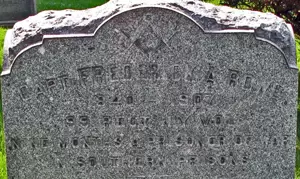
ROWE, FREDERICK A. (1837-1907). Captain, 99th New York Infantry, Company E; first lieutenant, New York Union Coast Guard, Company A. Rowe enlisted at New York City on May 28, 1861, as a first lieutenant, was commissioned into the Coast Guard on June 14, and was transferred into the 99th Infantry as a first lieutenant and adjutant on January 17, 1862. He was later promoted to captain on June 1, 1863, effective upon his transfer from the Field and Staff to Company E on June 29, 1863.
Wounded at Smithfield, Virginia, on January 31, 1864, Rowe was taken as a prisoner of war and paroled. Brigadier General Charles K. Graham, United States Army and commander of the Naval Brigade, wrote from Norfolk, Virginia, on February 2, 1864, describing a fierce gun battle at the intersection of Pagan Creek and the Nansemond River in which, “Captain Frederick A. Rowe, of the Smith Briggs, although severely wounded through the neck, remained at his post, gallantly fighting his vessel until she was entirely disabled.” He mustered out on October 21, 1864. He succumbed to nephritis. Section 196, lot 28212.
ROWE, HENRY CLAY (1842-1892). Private, 95th New York Infantry, Company E. A native New Yorker, Rowe enlisted at New York City as a private on April 3, 1862, and mustered into the 95th New York nine days later. He was taken twice as a prisoner of war, the first time at Gettysburg, Pennsylvania, on July 1, 1863, and was returned the next month on August 18. His regiment served with the Army of the Potomac, and he was taken prisoner at the Battle of the Wilderness, Virginia, in May 1864. He was imprisoned at Andersonville, Georgia, and released after seven months. He was honorably discharged at Annapolis, Maryland, in April 1865. After returning home he suffered for two years with “brain fever, chronic diarrhea and muscular rheumatism,” and was generally unable to work after that time by reason of debility. He applied for and received an invalid pension in 1890, certificate 624,617. At the time of his death, attributed to “cerebral softening,” he was living at the Inebriate Home in Hartford, Connecticut. Section 150, lot 12179.
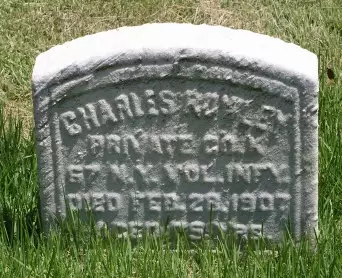
ROWLEY, CHARLES (1832-1907). Private, 67th New York Infantry, Company K. He enlisted on June 4, 1861, mustered into the 67th on June 24, and mustered out on July 4, 1864, at Brooklyn. Rowley died of nephritis, a kidney disease. Section 188, lot 15852.
ROWN, JOSEPH S. (1841-1895). Private, 8th Regiment, New York State National Guard, Company B. Rown enlisted and mustered into the 8th Regiment at New York City on May 29, 1862, and mustered out there after three months on September 10. As per his obituary in the New York Herald, he was a member of the George C. Strong Post #534 of the G.A.R., the Royal Arcanum and the Retail Grocers’ Association; members of those organizations were invited to attend his funeral. He last lived at 479 10th Street in Brooklyn. Section 54, lot 2823.
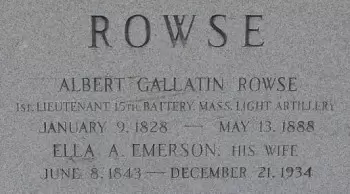
ROWSE (or ROUSE), ALBERT GALLATIN (1828-1888). First lieutenant, 15th Massachusetts Light Artillery. He enlisted on February 19, 1863, mustered into the 15th Massachusetts Light Artillery on March 4, 1863, and mustered out on August 4, 1865, at Boston, Massachusetts. Section N, lot 18019.
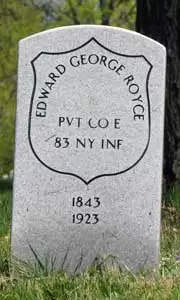
ROYCE, EDWARD GEORGE (1843-1923). Private, 83rd New York Infantry, Company E. Royce was 5′ 11″ tall, with a light complexion, blue eyes, and brown hair. A clerk, he enlisted at New York City as a private and mustered into the 83rd New York on May 27, 1861. Wounded at Antietam, Maryland, with gunshot wounds in the thigh and neck, on September 17, 1862, he was treated in a field hospital and then entered the General Hospital at Camp Curtin near Harrisburg, Pennsylvania, on September 23, 1862. He was discharged for those wounds soon thereafter, on October 5.
Subsequently, he worked as a merchant and, in 1879, applied for and received an invalid pension, certificate 203,326. He lived in New York City until 1878, then moved to Brooklyn where he last lived on 22nd Street. His death was attributed to cardiac disease. Shortly after his death in 1923, Mary Royce applied for and received a widow’s pension, certificate 939,814. Section 82, lot 3424.
ROYLE, CHARLES (1838-1907). Private, 3rd New York Infantry, Company A. A native of Birmingham, England, Royle enlisted as a private at Brooklyn on April 18, 1861, mustered into the 3rd New York on May 14, and was discharged for disability on October 2, 1861. He last lived in Brooklyn. He succumbed to pleurisy. Section 15, lot 17263, grave 2221.
RUCK, JOHN (1829-1904). First sergeant, 42nd New York Infantry, Company B. Of German birth, he enlisted at Great Neck, New York, as a first sergeant on June 22, 1861, mustered into the 42nd on that day, and deserted at some point. He may also have served as a first lieutenant in the 73rd New York Infantry, Companies D and I. Ruck last resided on West 69th Street in Manhattan. He died of cardiac disease. Section 114, lot 17124.
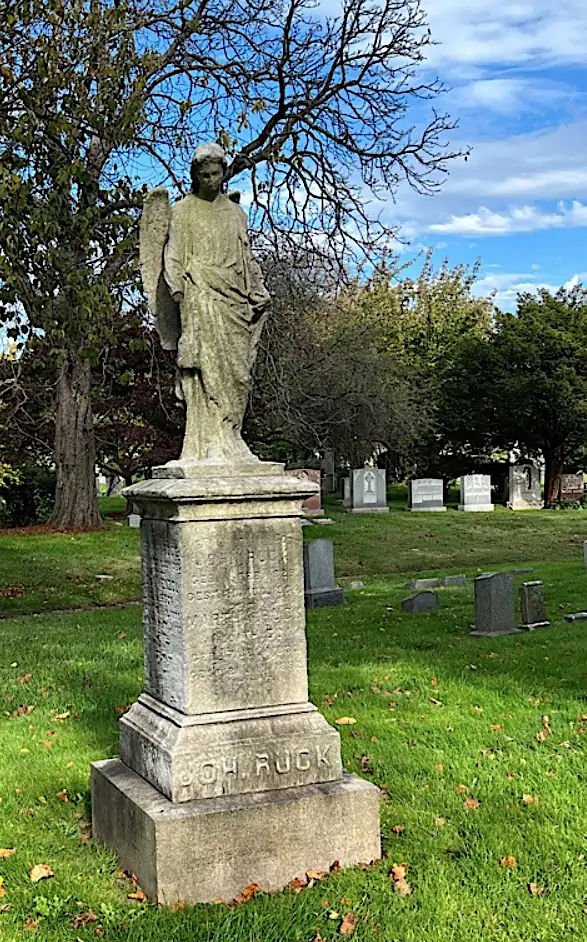
RUDD, FRANK (1843-1911). Unknown soldier history. According to his obituary in The New York Times, Rudd, who was born in New York City, was a member of the Grand Army of the Republic, an organization of Civil War veterans. A graduate of Harvard Law School, Rudd practiced law in New York City. He last resided at 40 Orange Street, Brooklyn. Section 172, lot 20670.
RUDMAN (or RODMAN), JOHN (1843-1916). Private, 5th New York Infantry, Company E; 146th New York Infantry, Company D. Born in New York, Rudman was 5′ 9½” with hazel eyes and dark hair. A machinist by trade, he enlisted at New York City on August 22, 1862, mustered into the 5th on August 25, and transferred into the 146th New York on May 4, 1863. He was slightly wounded in the right arm at North Anna, Virginia, in May 1864, detached to guard Confederate prisoners of war at Elmira, New York, on October 24, 1864, and mustered out on June 5, 1865, at Elmira. His last residence was 475 Monroe Street in Brooklyn. He died from hemiplegia. Section 16, lot 14888, grave 1322.
RUDOLPH, JACOB (1836-1869). Private, 39th New York Infantry, Company H. Originally from Germany, Rudolph enlisted at New York City as a private on May 17, 1861, mustered into the 39th New York on May 28, and was discharged for disability on April 7, 1863, at Centreville, Virginia. His last residence was 517 West 24th Street in Manhattan. Section 122, lot 17806, grave 335.
RUFF, SEGIMUND (or SIGMUND, SEGISMUND) (1838-1865). Private. 9th New York Infantry, Company F. Of German origin, he enlisted as a private on April 23, 1861, at New York City, mustered into the 9th on May 4, and mustered out on May 20, 1863, at New York City. His last residence was 142 3rd Avenue, Manhattan. Section 115, lot 8999, grave 341.
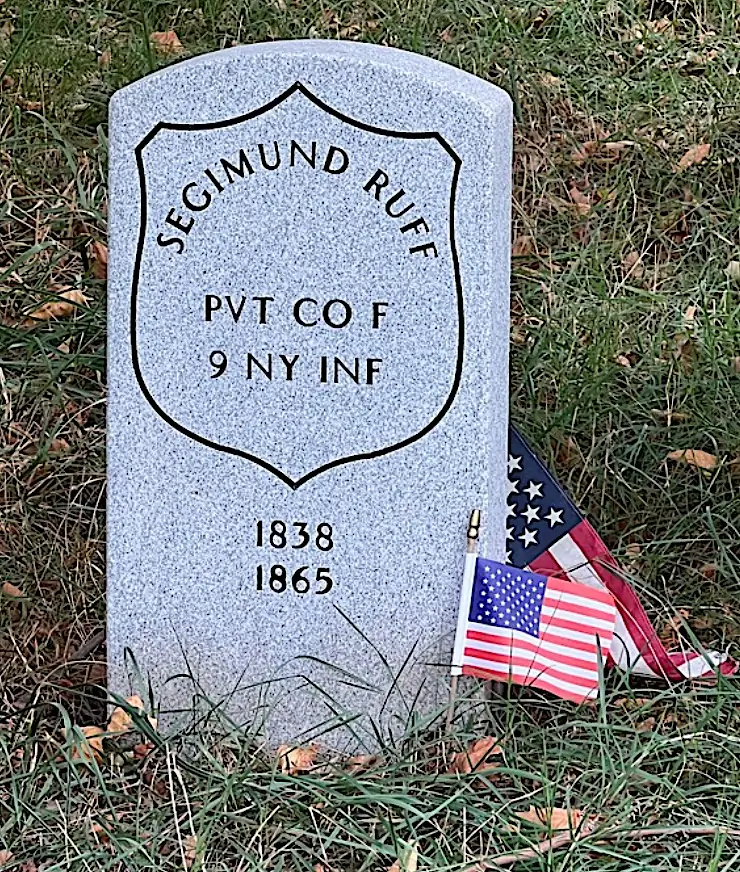
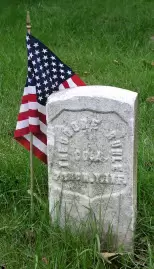
RUHLE, THEODORE F. (1844-1898). Private, 163rd New York Infantry, Company D; 73rd New York Infantry, Company A. After Ruhle enlisted on August 15, 1862, at New York City, he mustered into the 163rd on October 10, 1862. On January 18, 1863, he transferred into the 73rd New York. He succumbed to heart disease. Section 115, lot 4196.
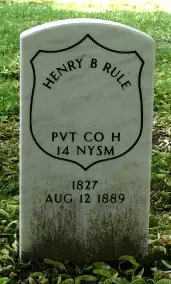
RULE, HENRY B. (1827-1889). Private, 84th New York (14th Brooklyn) Infantry, Company H. Born in Scotland, Rule enlisted as a private at Brooklyn on August 22, 1862, and mustered into the 14th the next day. Wounded in action at the Battle of Antietam, Maryland, on September 17, 1862, he was discharged for disability on December 22 of that year at Fairfax Seminary, Virginia. According to the 1880 census, he was working as a baker. He last lived at 128 Carlton Avenue in Brooklyn. He died of valvular disease of the heart. Section 2, lot 8445.
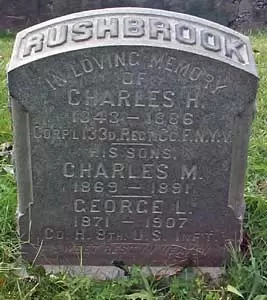
RUSHBROOK, CHARLES H. E. (1843-1886). Corporal, 133rd New York Infantry, Company F. A Brooklyn native, Rushbrook enlisted as a private at New York City on August 21, 1862, and mustered into the 133rd New York the next month on September 24. He was wounded on June 14, 1863, at Port Hudson, Louisiana, was promoted to corporal on about October 15, 1864, and mustered out at Washington, D.C., on June 6, 1865.
In 1871, Rushbrook’s application for an invalid pension was granted, certificate 117,632. He last lived at 336 East 117th Street in Manhattan. His widow, Mary E. Rushbrook, received a pension after his death from phthisis in 1886, certificate 227,039. A minor’s pension was granted in 1893, certificate 383,528. Section 3, lot 18372.
RUSHER, WILLIAM A. (1845-1901). Private, 9th New York Infantry, Company D. On August 15, 1861, he enlisted as a private at New York City and mustered in the same day. He served with the 9th until he was discharged for disability on December 29, 1862, at Washington, D.C. Rusher last resided at 157 Carroll Street, Brooklyn. His death was attributed to pneumonia. Section 146, lot 25021, grave 7.
RUSHMORE, GEORGE (1848-1917). Private, 13th Regiment, New York State National Guard, Company B. Rushmore, a native of Brooklyn, served in the 13th National Guard for three months from May 30-September 1862, and for 30 days when the regiment was reactivated in 1863. His regiment fought at the Battle of Gettysburg, Pennsylvania. A store clerk, he last lived in Huntington, New York, where he died of chronic interstitial nephritis. Section 26, lot 4154.
RUSSELL, ANDREW J. (1848-1899). Private, 168th New York Infantry, Company K; 56th Regiment, New York State National Guard, Company I. Russell, who was born in New York City, enlisted there as a private on February 27, 1863, the same day that he mustered into the 168th New York. He mustered out on October 31, 1863, at Newburgh, New York. In 1864, he re-enlisted as a private and served for 100 days with Company I of the 56th New York State National Guard. In 1892, he applied for an invalid pension that was awarded, certificate 843,442. His last residence was on East High Street in Somerville, New Jersey. Russell’s death was caused by rheumatism of the heart. Jennie Russell, received a widow’s pension in 1899, certificate 495,584. Section 82, lot 2360, grave 4.
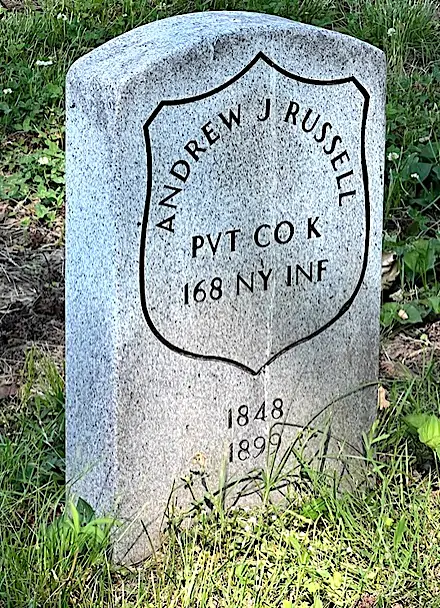
RUSSELL, JOHN F. (1840-1898). Private, 2nd New Jersey Infantry, Company F; 6th California Infantry, Company I. Originally from Scotland, Russell enlisted as a private on May 28, 1861, and mustered into the 2nd New Jersey Infantry that same day. As per one soldier record, he deserted from the hospital on August 7, 1862. The desertion notation appears to be inaccurate; he would not have received a pension if that were the case. Russell subsequently enlisted as a private at Benicia Barracks, California, on April 22, 1865, and mustered into Company I of the 6th California Infantry. He mustered out on December 20, 1865, at Presidio, San Francisco, California. In 1879, Russell applied for and received an invalid pension, certificate 185,022. In civilian life, he was in the hotel business. He died in Hoboken, New Jersey. After his death, Agnes Russell applied for and received a widow’s pension, certificate 6682,264. Section 16, lot 17245, grave 393.
RUSSELL, THEODORE (1839-1862). Captain, 61st New York Infantry, Company F; private, 7th Regiment, New York State Militia, Company A. A resident of 130 West 34th Street in Manhattan, he enlisted in the 7th for its 1861 activation, which lasted from April 18, 1861, to June 3, 1861. He re-enlisted at New York City as a captain on October 1, 1861, and was commissioned into the 61st New York three days later. The 61st was part of the Army of the Potomac and took part in the Peninsula Campaign. Russell was killed in battle on June 1, 1862, at Fair Oaks, Virginia. Colonel Francis C. Barlow, commanding officer of the 61st, wrote the next day in his field report from Fair Oaks Station, Virginia, that Russell (and other officers) did not shrink or fail in confronting the enemy and were “shot dead while doing their duty firmly, calmly, and nobly…” Interment at Green-Wood was on June 15, 1862. Section 21, lot 8870.
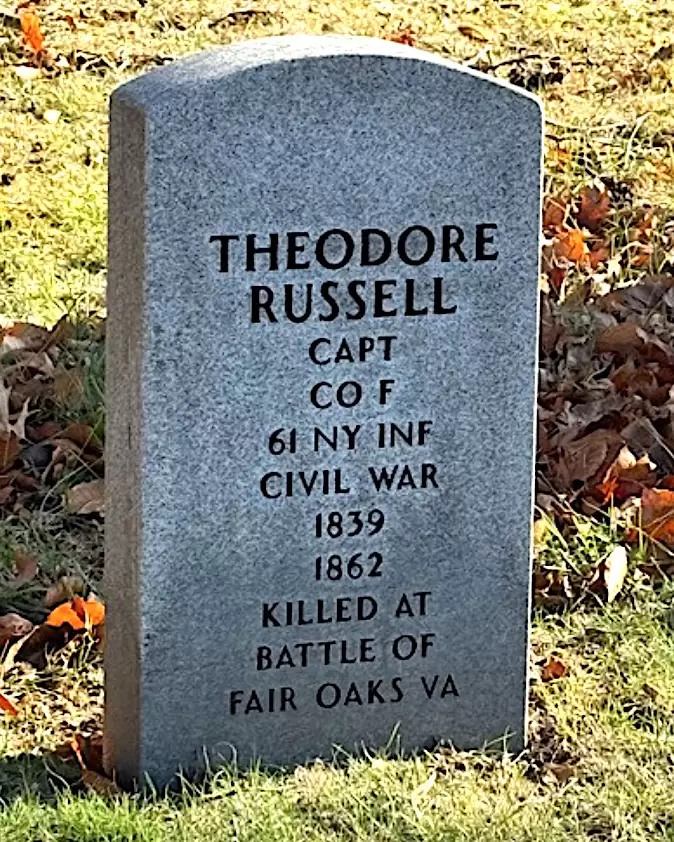
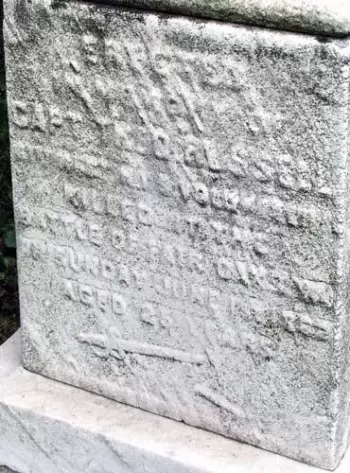
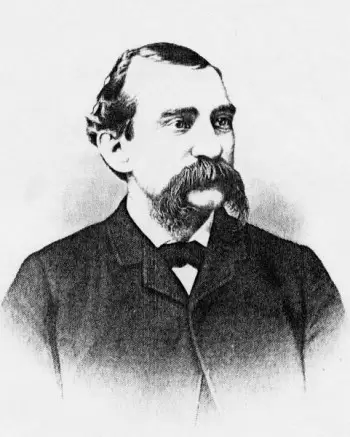
RUTAN, THOMAS BENTON (1837-1903). Sergeant, 139th New York Infantry, Company A. Born in Newark, New Jersey, his French ancestors originally spelled their name Routin. His family moved to New York City in 1845, and he followed his father into the building trades as a mason and contractor. He enlisted at Brooklyn on August 21, 1862, and mustered into the 139th New York the next month on September 9. Among the Virginia battles in which his regiment engaged were Fair Oaks, Cold Harbor, and Petersburg. His regiment was the first to enter Richmond, Virginia, after its capture. Rutan mustered out on June 19, 1865, at Richmond.
Rutan returned to his business after the War, and constructed many buildings and churches in Brooklyn such as the 14th Regiment Armory, the Brooklyn City Railroad Building, Mount Prospect Water Tower, and the Federal Building which was used as a post office and United States courthouse. In addition, he was appointed commissioner of buildings of the old city of Brooklyn in 1892, was active in Democratic Party politics, was president of the 139th’s Veterans Association and held leadership positions in the Rankin Post #10 of the G.A.R. Rutin was also active in many community organizations including the Knights Templar, the Constitution Club, and the Knights of St. John and Malta. He last resided at 576 Madison Street in Brooklyn. He died of heart disease. Section 147, lot 21977, grave 2.
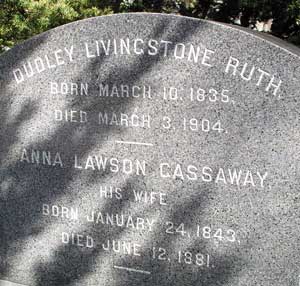
RUTH, DUDLEY LIVINGSTONE (1835-1904). Assistant paymaster, United States Navy. A native of New York City, Ruth’s biographical sketch indicates a birth year of 1837, but his gravestone at Green-Wood is inscribed with 1835 as the year in which he was born. He was appointed assistant paymaster in the Navy on August 10, 1862, and attached to the USS Louisville in the Mississippi Squadron. He took part in the attack on Vicksburg, Mississippi, in December 1862 and in its subsequent fall. The USS Louisville was the first United States Navy ship to reach the docks of Vicksburg and receive the surrender of the wharfs on the morning of its capitulation. The crew was personally mentioned in orders by General Sherman for gallantry in this action. In addition, Ruth participated in other Mississippi battles including the Deer Creek expedition and the capture of Grand Gulf as well as the Red River (Louisiana) expedition. He tendered his resignation on October 23, 1865. Ruth served in the detail for Ulysses S. Grant’s funeral ceremonies. His last residence was 458 8th Street in Brooklyn. He died of nephritis. His interment at this site at Green-Wood was in 1907. Section 190, lot 31995, graves 7 and 8.
RUTZLER (or REUTZLER), ENOCH (1847-1908). Private, 139th New York Infantry, Company B. Born in New York City, Rutzler’s biography in G.A.R.’s Ulysses S. Grant Post #327’s sketchbook indicates that he was born in 1846 although his tombstone is inscribed with 1847 as his year of birth. His family moved to Southold, Long Island, where he was educated. After enlisting at Brooklyn on August 26, 1862, Rutzler mustered into the 139th New York on September 9. Among the battles in which he participated were these in Virginia: Second Williamsburg, White House Landing, Chapin’s Farm, Baltimore Cross Roads, Bermuda Hundred, Swift Creek, Fort Darling, Cold Harbor, Petersburg, and the capture of Richmond (where his regiment was the first to enter and where he remained after its capture). He was promoted to corporal after the Battle of Chapin’s Farm. He mustered out with his company on June 19, 1865.
Returning to Brooklyn after the War, Rutzler established a steam-heating business under his name. He was a member of the Ancient Order of United Workmen, the Royal Arcanum, the Ulysses S. Grant Post #327 of the G.A.R., and the American Legion of Honor among other organizations. Section 197, lot 30712, grave 3.
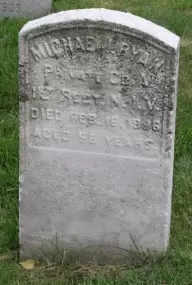
RYAN, MICHAEL (1838-1896). Private, 1st New York Infantry, Company A. He enlisted and mustered into the 1st New York as a private on May 9, 1861, and mustered out on May 25, 1863, at New York City. He succumbed to cirrhosis of the liver. Section 15, lot 17263, grave 945.
RYCKMAN, SAMUEL P. (1837-1874). Private, 59th New York Infantry, Company D. Ryckman, who was born in New York State, enlisted as a private at New York City on July 18, 1862, the same day that he mustered into Company D of the 59th New York. He was wounded in action at the Battle of Antietam, Maryland, and according to his soldier history, deserted from the regiment on an unknown date. His last residence was 243 East 84th Street in Manhattan Street. His death was attributed to phthisis. Section 68, lot 3896.
RYDELL, ANDREW J. (1844-1907). Private, 111th Pennsylvania Infantry. Of Swedish birth, Rydell served with the 11th Pennsylvania in an unidentified company. Further details are unknown. His last address was 410 East 88th Street in Manhattan. He died from stomach and liver cancer. Section 202, lot 28878, grave 3.
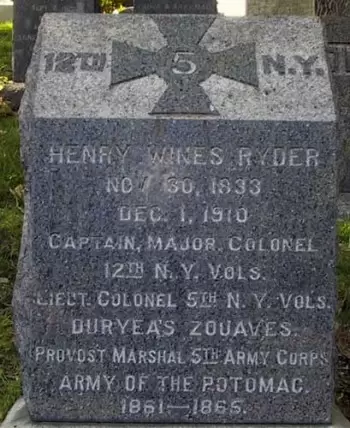
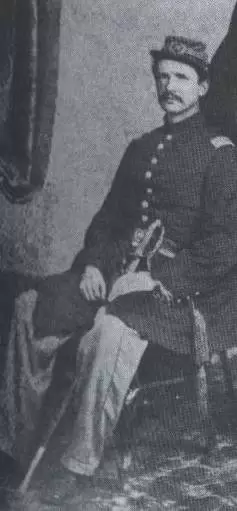
RYDER, HENRY WINES (1833-1910). Lieutenant colonel, 5th New York Veteran Infantry; captain, 12th Regiment, New York State Militia, Company E. In 1861, Henry W. Ryder was captain of Company E, 12th New York State Militia when it was activated for three months, from May 2 until August 5, 1861. A year later, he was wounded in the head at the Battle of Second Bull Run, Virginia. He was acting aide-de-camp for Brigadier General Daniel Butterfield, and then was appointed Provost Marshal of the 5th Army Corps in 1863. Ryder was promoted to major in 1864, and then became major of the 5th New York Veteran Infantry. He was promoted to lieutenant colonel and then colonel the same year, but both appointments were declined. In April 1865, he did become lieutenant colonel of the 5th New York Veterans, and he mustered out at Hart’s Island, New York Harbor, on August 21, 1865. He last lived in Newark, New Jersey where he died of pneumonia. Section 119, lot 9102.
RYKER, HENRY A. (1831-1893). Private, 71st Regiment, New York State National Guard, Company G. A New York native, he enlisted as a private at New York City on May 28, 1862, mustered into the 71st Regiment that day, and mustered out on September 2, 1862, at New York City. He last lived at 32 Remsen Street in Brooklyn. Ryker’s death was caused by pneumonia. Section 14, lot 19438, grave 273.
